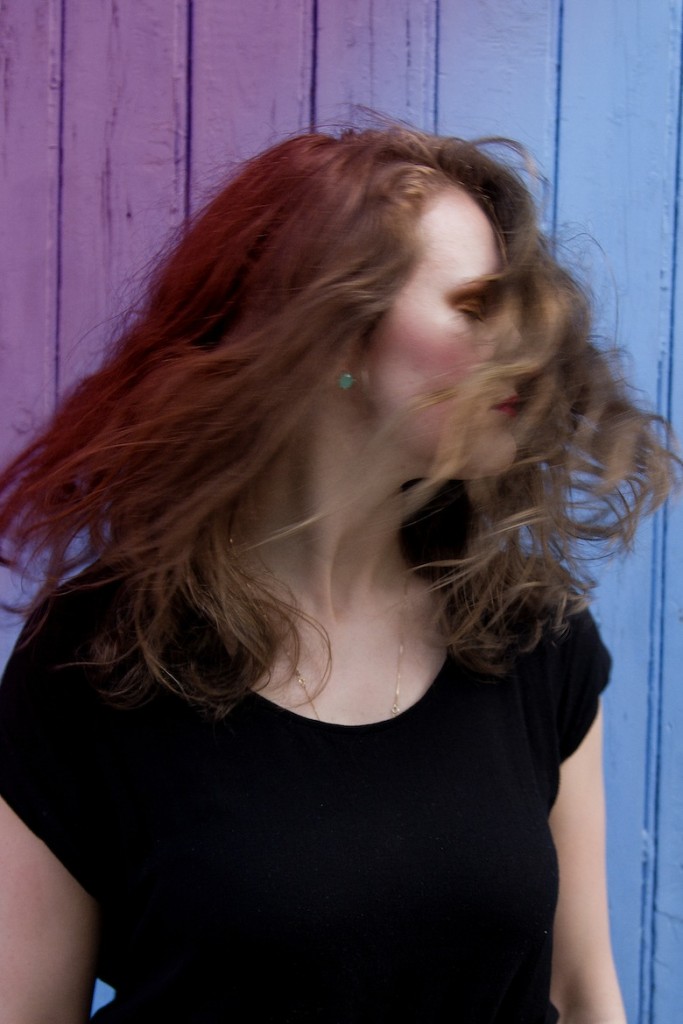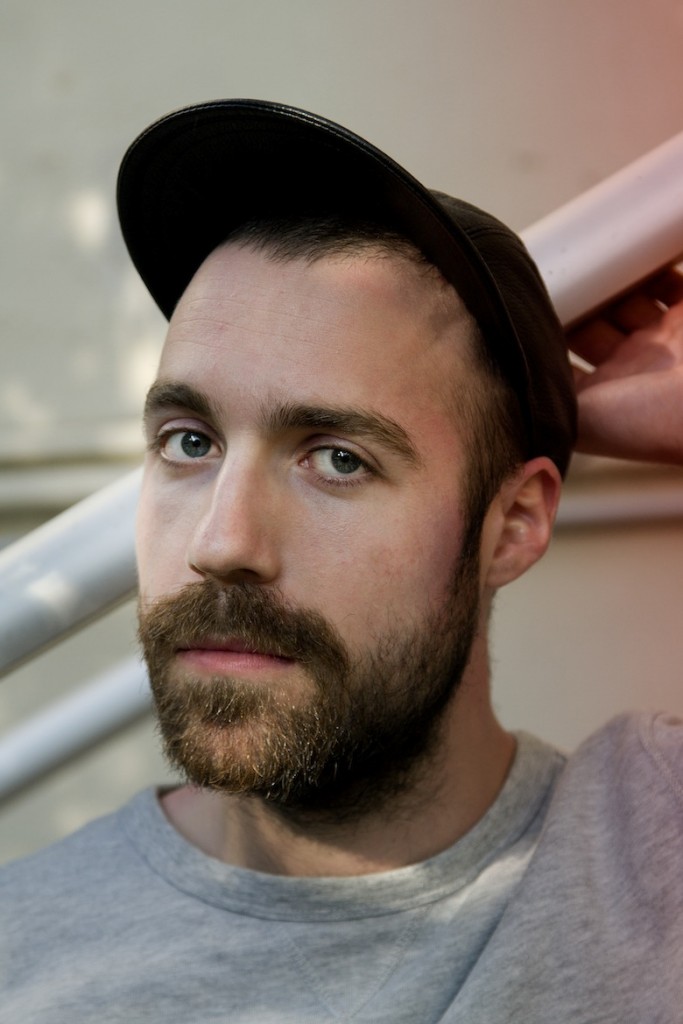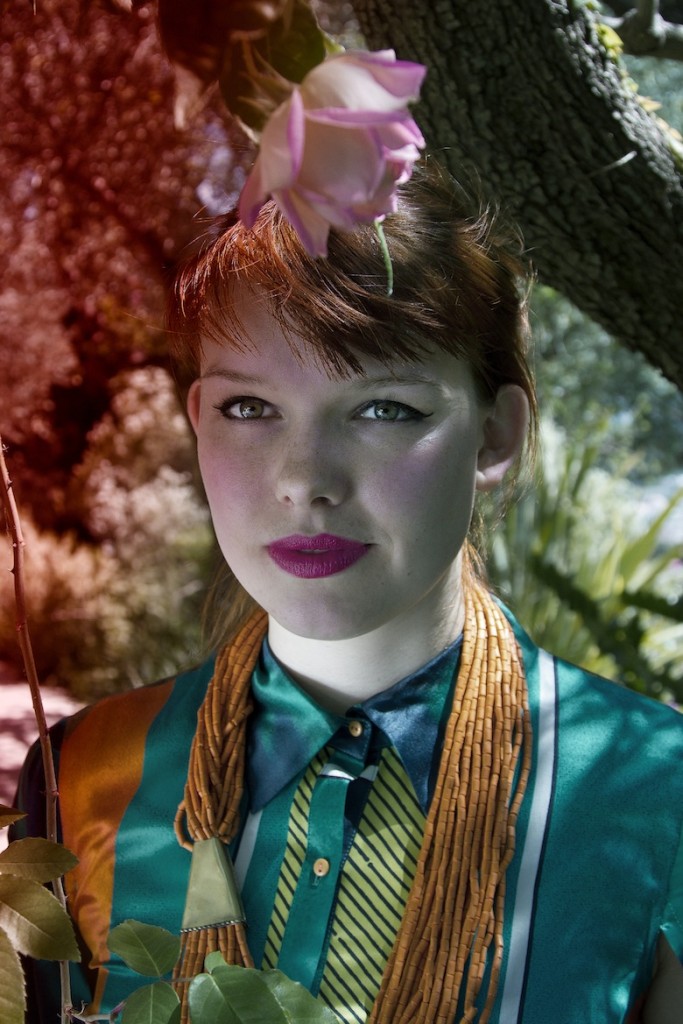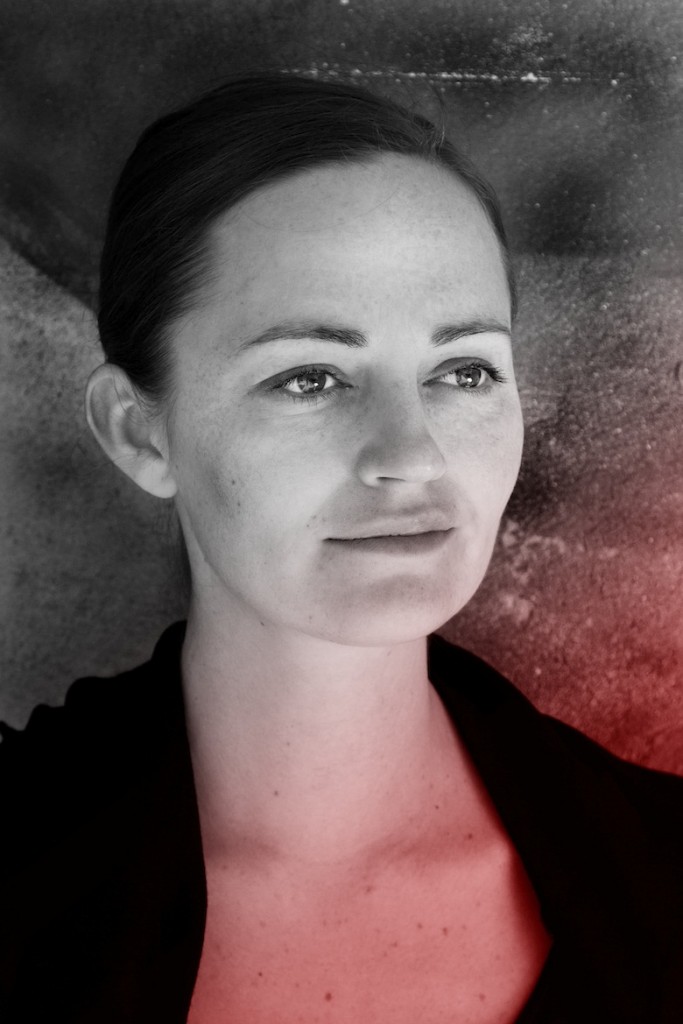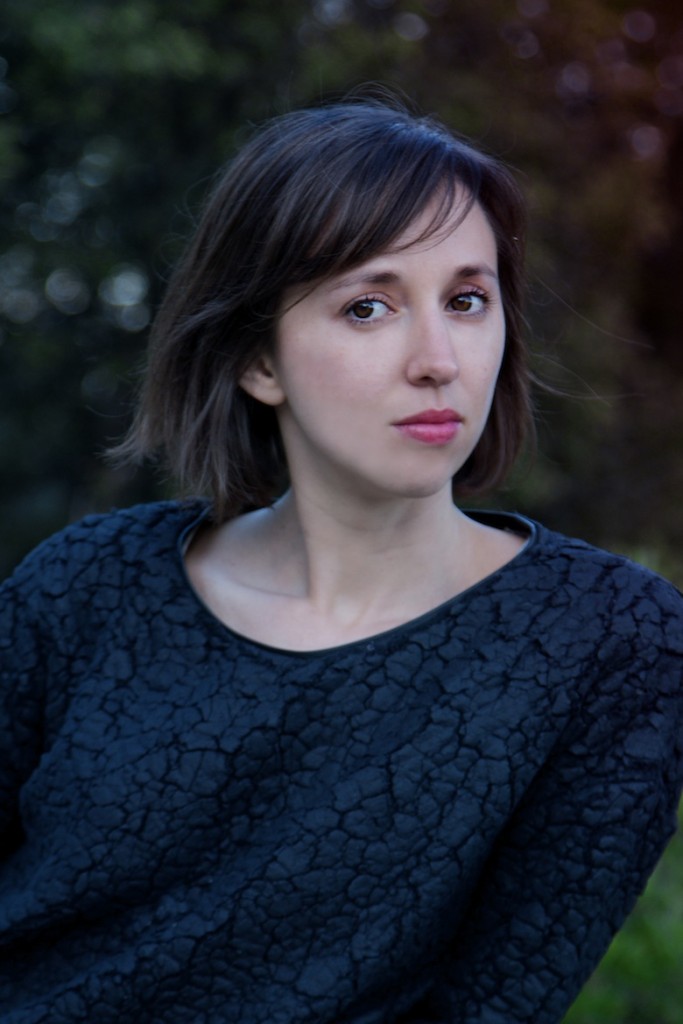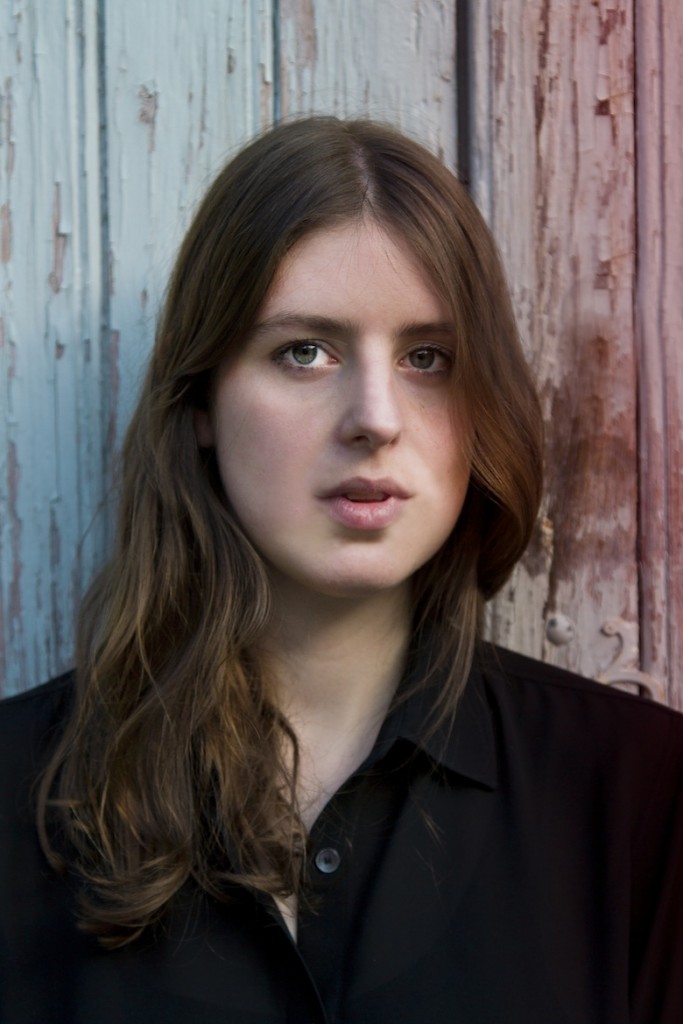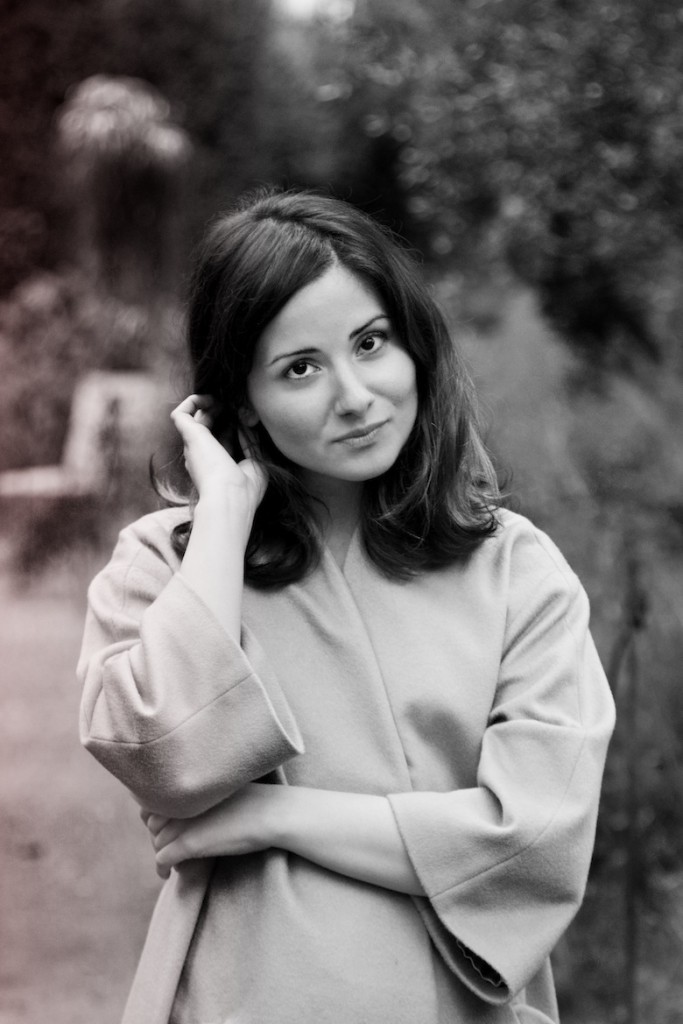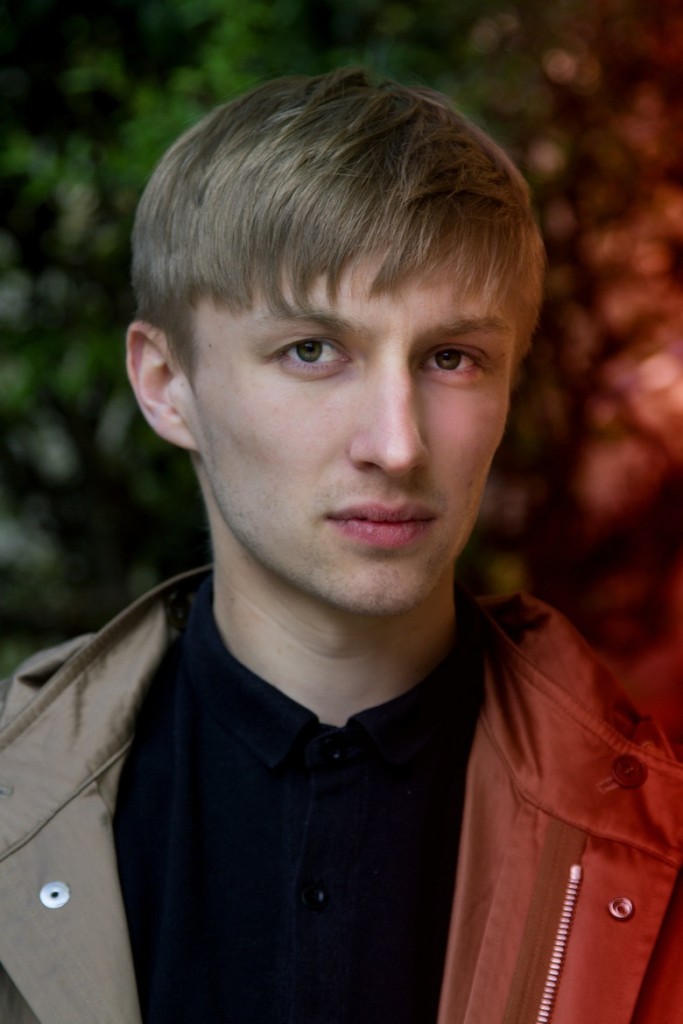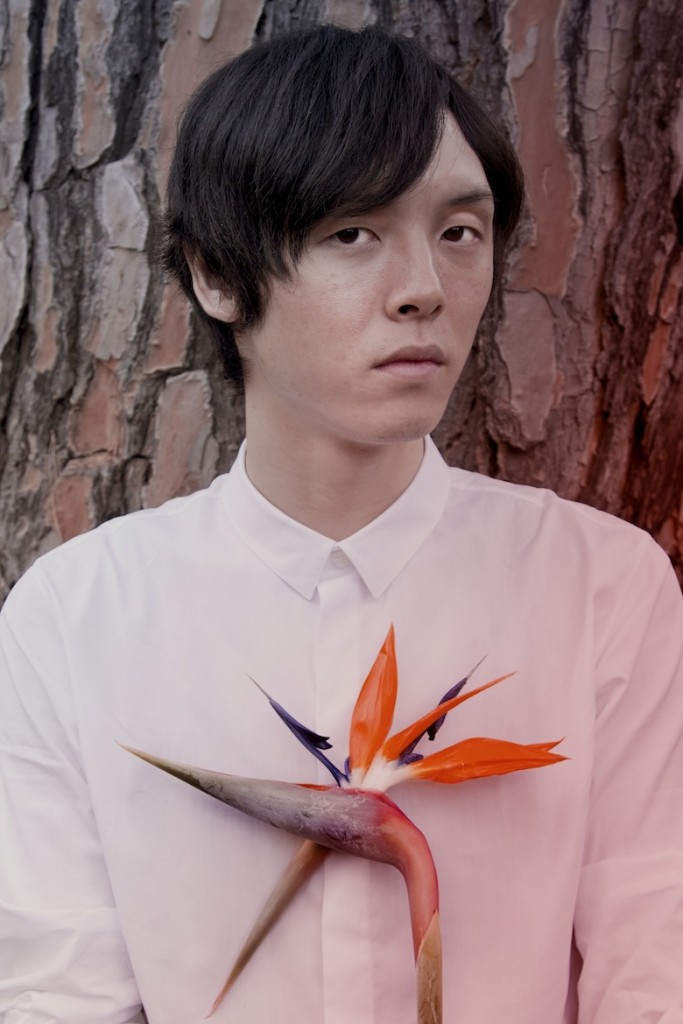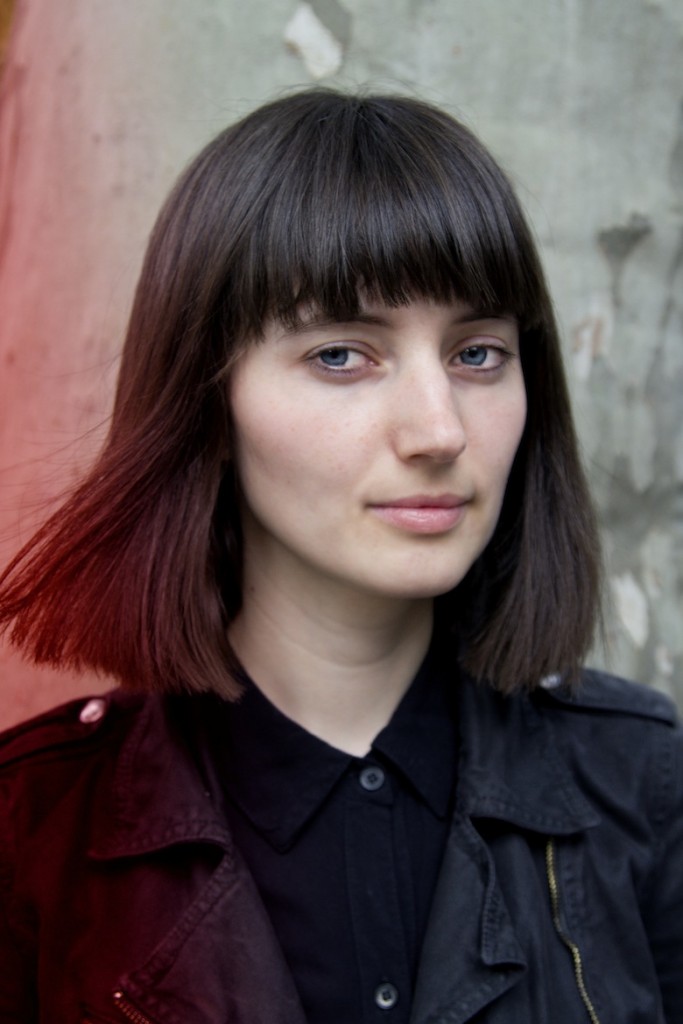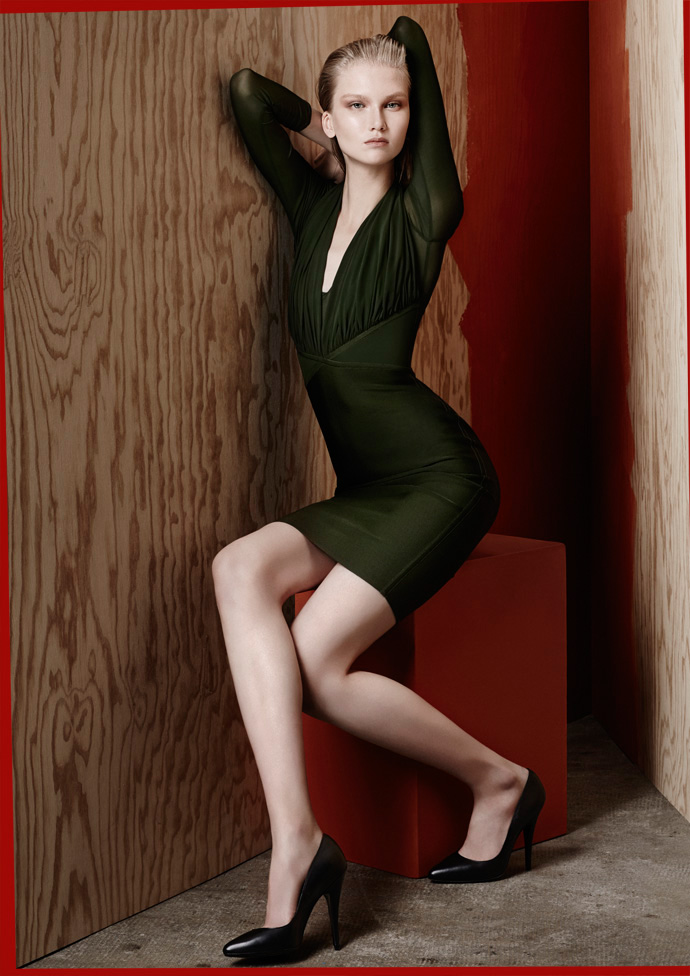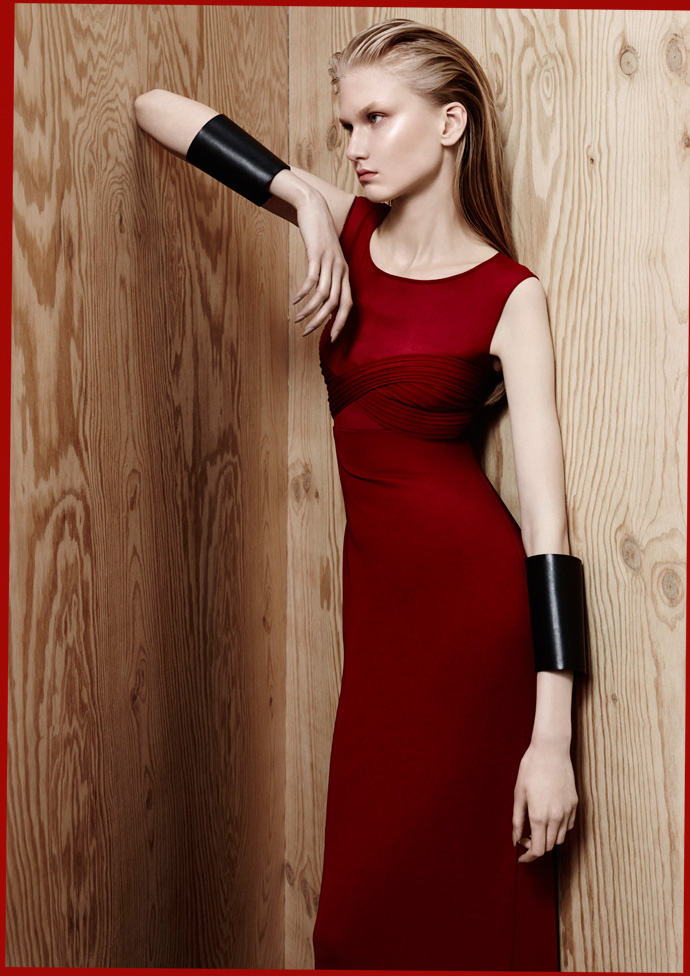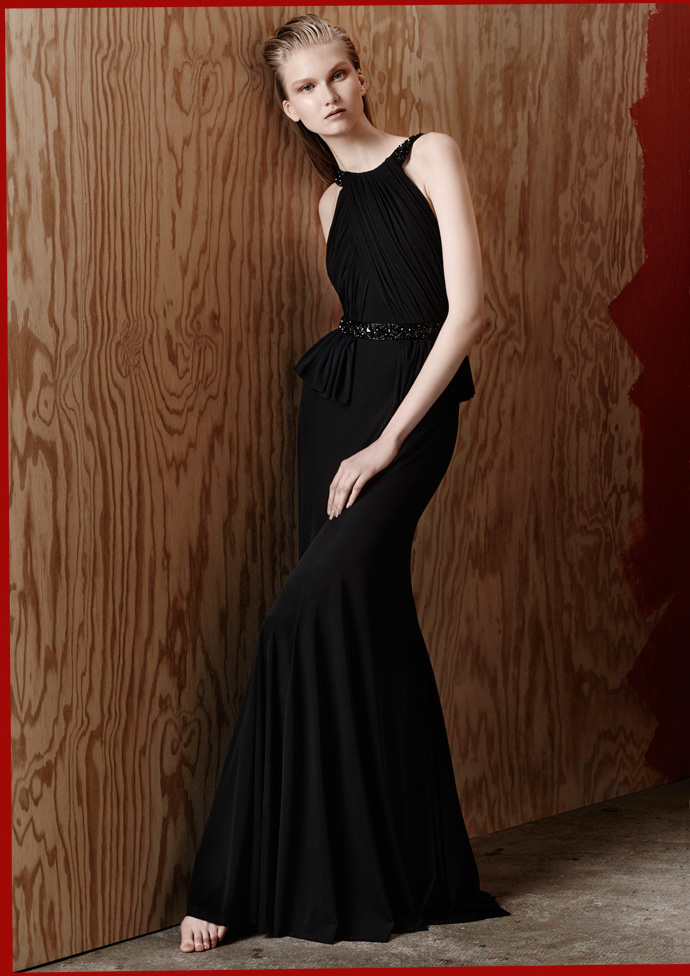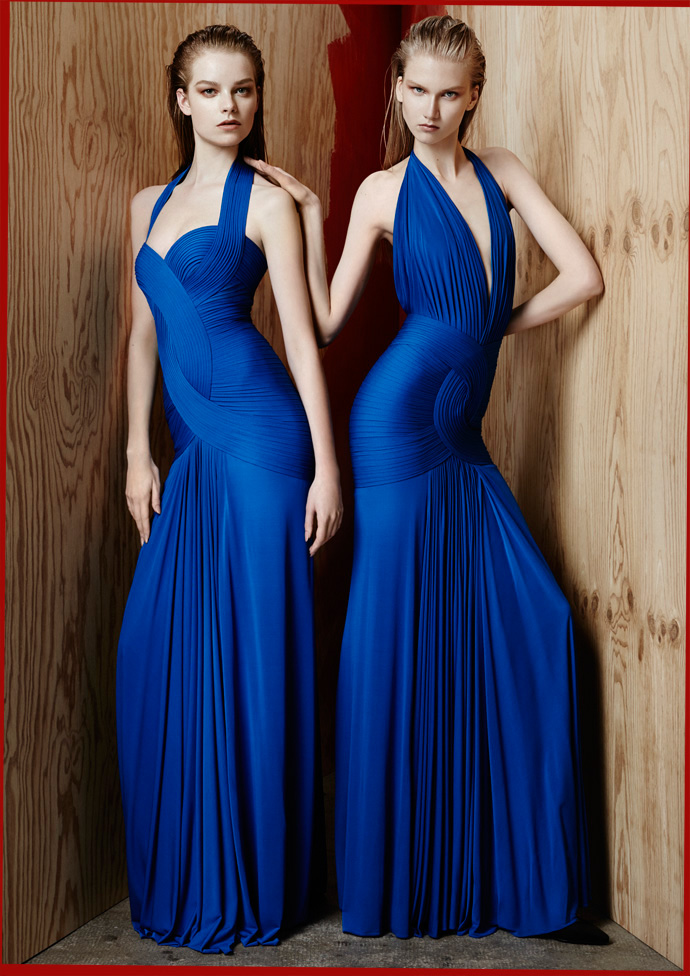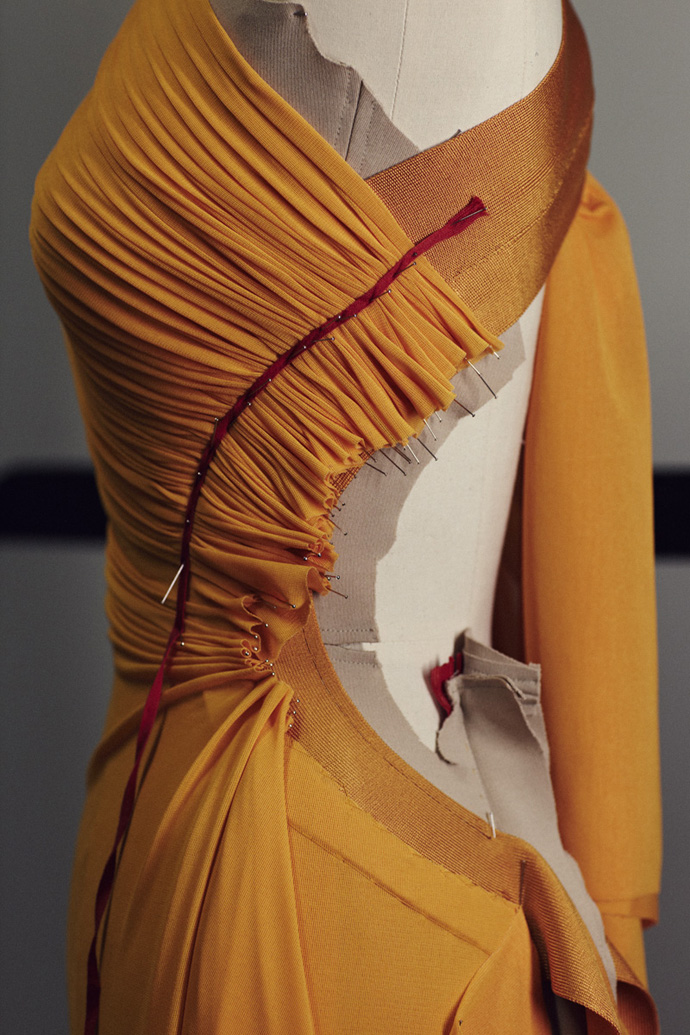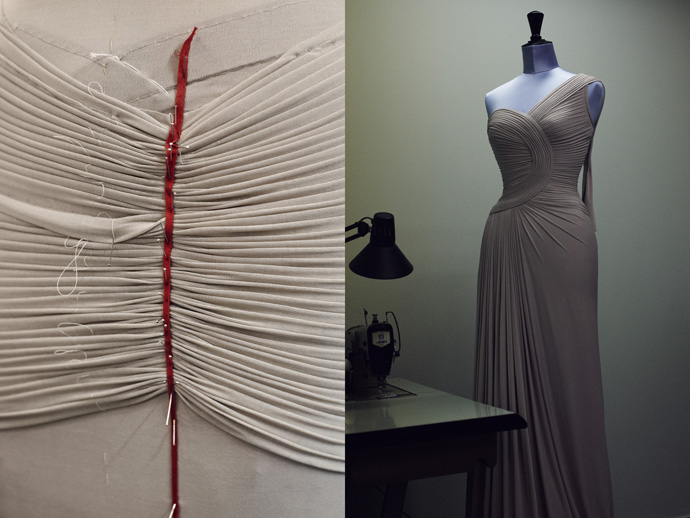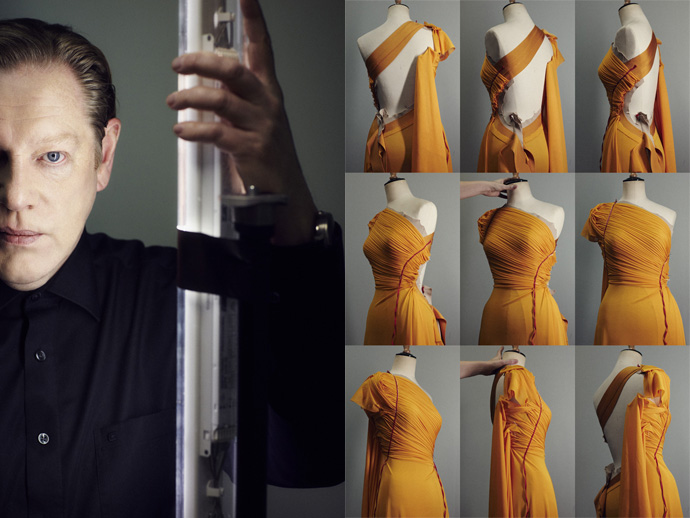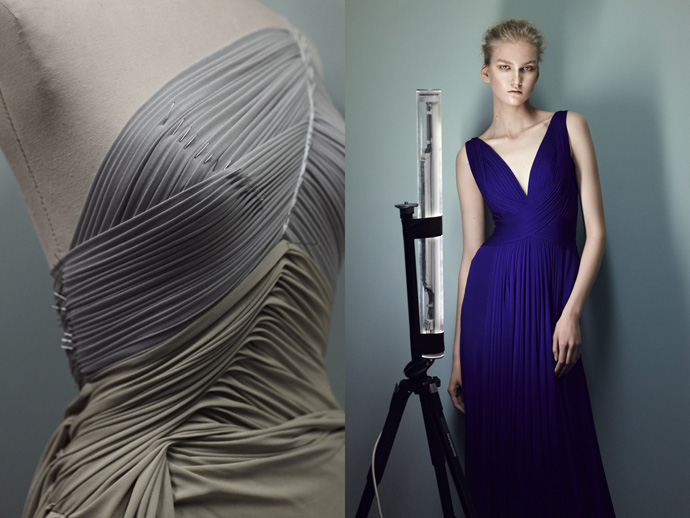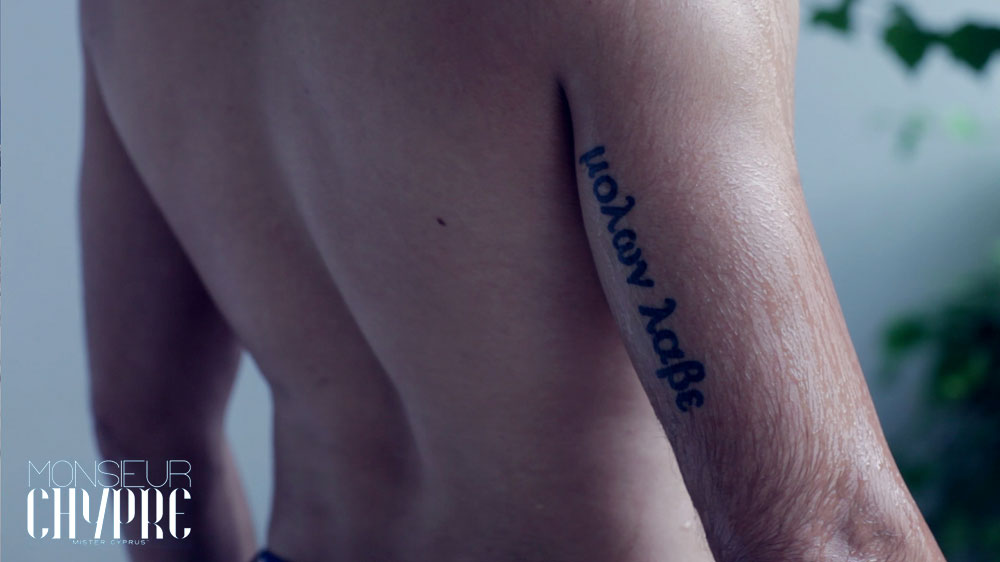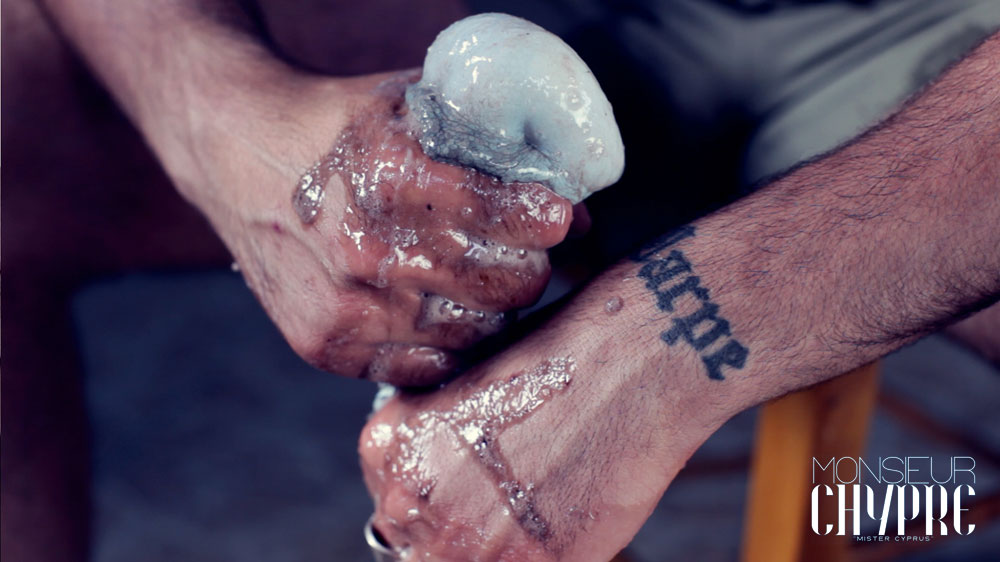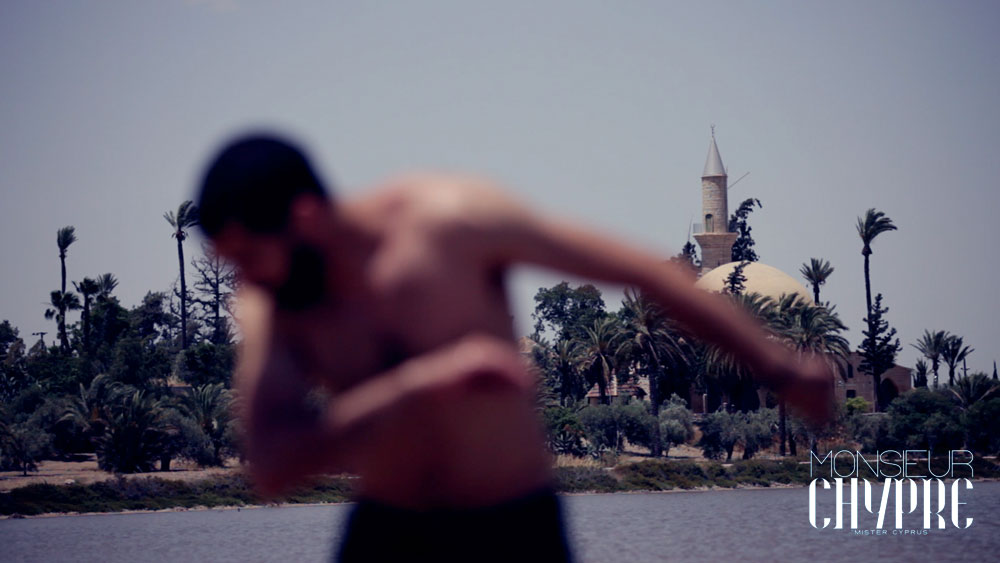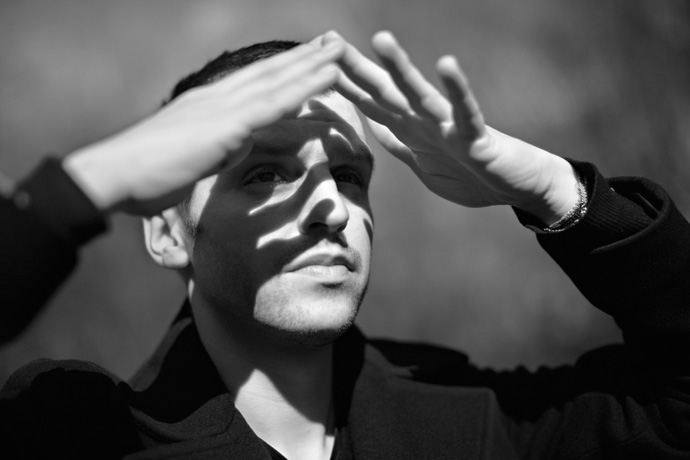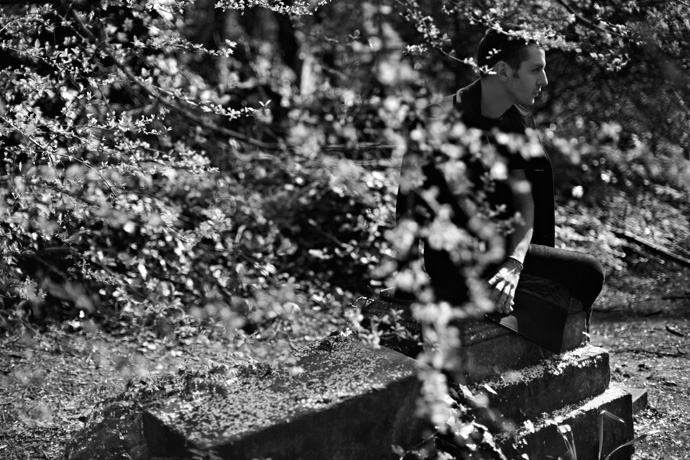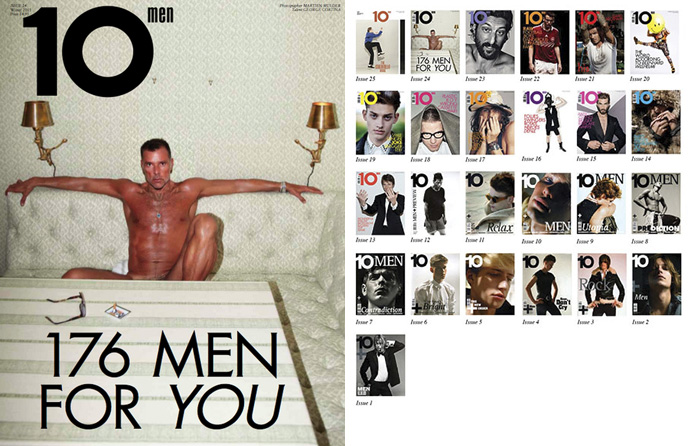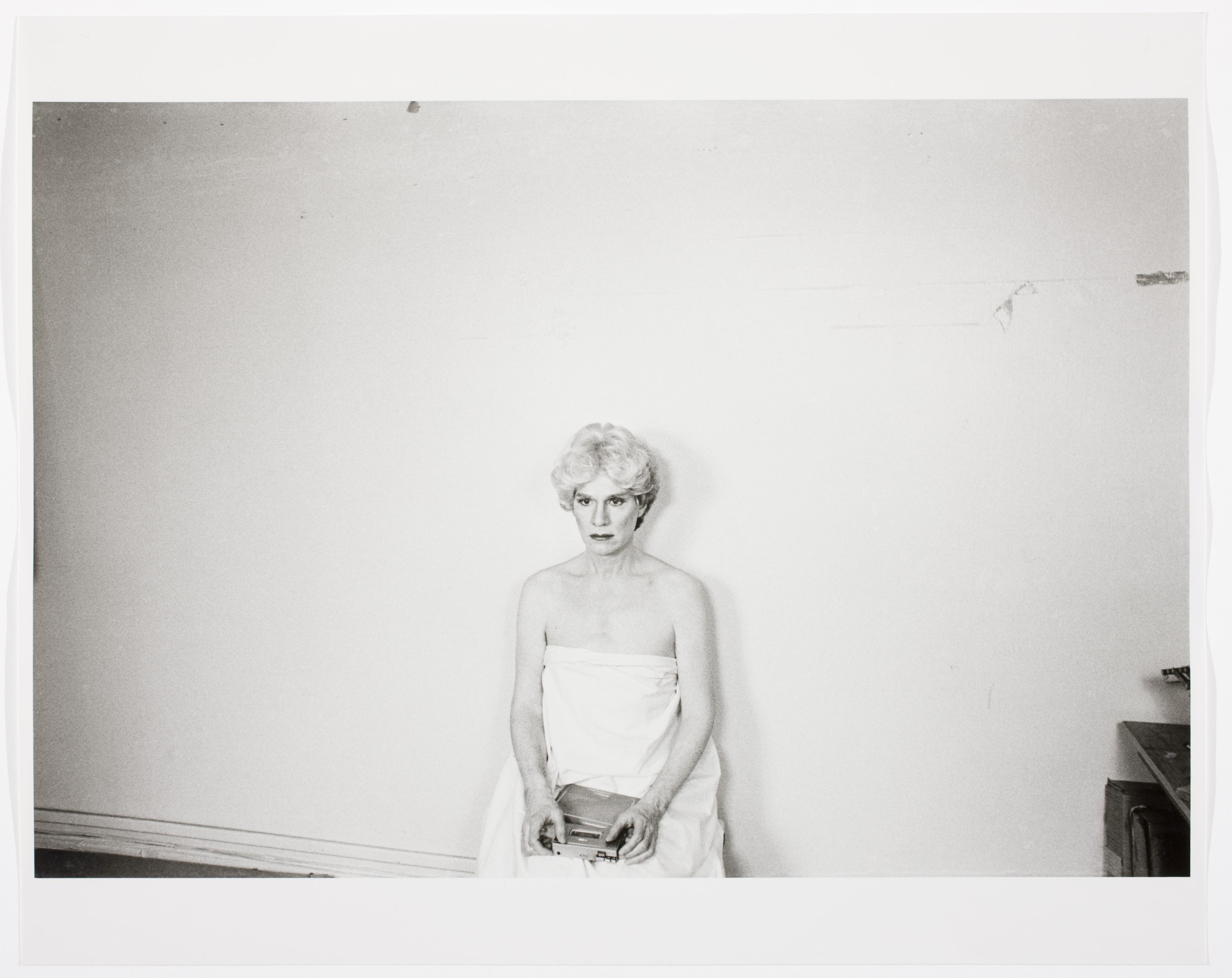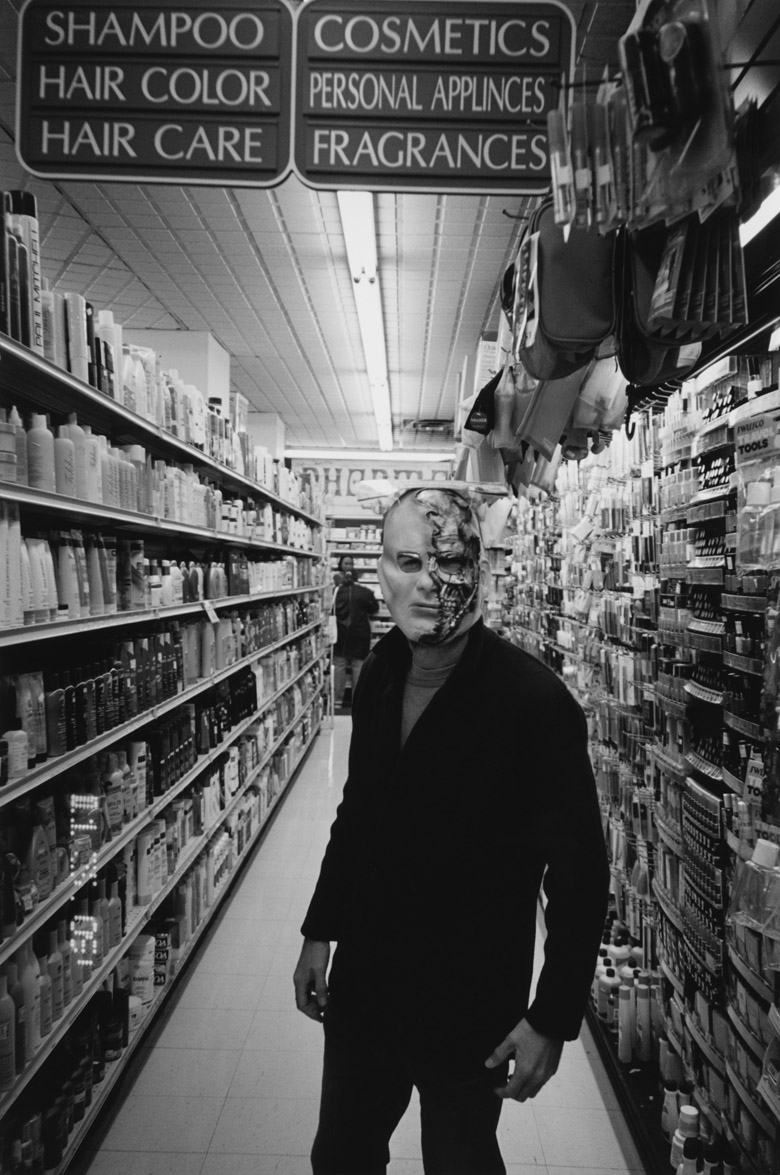-

#AllEyesOnHyeres2014: Meet the 10 Competing Designers
-In preparation for their meeting with the Design Jury, the 10 Competing Designers hurried around making last-minute adjustments and consulting with stylists, while The Stimuleye spent some time getting to know each candidate.
Herewith, a selection of video, photography, and text that offer brief introductions to each of these talented young designers.
All Photos by Filep Motwary
Marit Ilison
Who are you? Your age, your origin, your background, type of collection?
My name is Marit Ilison, I’m 29 years old and live and work in Tallinn, Estonia. I have a diploma in pattern making and I studied one year as an exchange student at Danish Design School before receiving my MA degree in Fashion Design from the Estonian Academy of Arts in 2008. Since then I have been working as a freelance artist and designer, creating in the fields of conceptual art, fashion, costume design, site-specific installations, perceptional experiences and exhibition design. I also teach and play drums in a psychedelic band.How would you describe Hyères in three words?
Palms, unreal, friendly.What has been your favorite part of the process so far?
Meeting like-minded people and collaborating with small local artisans in Tallinn. It is so wonderful how so many people have believed in my work and helped me to execute it.What is your collection about? Please explain your inspiration and starting point, and how it has evolved in the process.
Regardless of the discipline, my main goal is always to create memorable experiences and I always start from a feeling I want to create or an idea I want to express. Longing for Sleep is inspired by my haunting wish to sleep during the dark wintery time called kaamos. Kaamos is a word only know in Estonian and Finnish and it’s referring to the time from November to January when the days are very short and it barely gets light. On one side I would only like to stay in bed and daydream at that time, but on the other side I feel conscience pricking me, which reminds that I should actually be working instead of sleeping. To materialize the feeling I’ve created a collection using original vintage Soviet woolen blankets.In what ways you think participating in a Festival like Hyeres will help you in the future?
It is a truly unique chance to present my work to wider audience and get the spotlight on it. I am looking forward to meet like-minded people and find exciting future collaborations in fashion design, site-specific installations and experiences.Louis Gabriel Nouchi
Who are you? Your age, your origin, your background, type of collection?
My name is Louis Gabriel Nouchi. Im french, I’m 26 years old. I live in Brussels. I’m studying at La Cambre.How would you describe Hyères in three words?
Intense, exciting, sunny.What has been your favorite part of the process so far?
To see my clothes worn by a real model.What is your collection about? Please explain your inspiration and starting point, and how it has evolved in the process.
I’ve made a collection about the movie Princess Mononoke from Hayao Miyasaki and the notion of balance between opposite forces that have to live together in harmony.In what ways you think participating in a Festival like Hyeres will help you in the future?
I hope it will help me to meet professionals and create contacts for whatever is going to happen after school.Liselore Frowjin
Who are you? Your age, your origin, your background, type of collection?
My name is Liselore Frowijn, I am 22 years old and I come from the Netherlands. I graduated Cum Laude less then a year ago at ArtEZ Institute of the Arts in Arnhem, the Netherlands, on my bachelor fashion design. I designed a collection womenswear which is about the contrast between sportswear and luxury with the use of self designed fabrics.How would you describe Hyeres in three words?
I would describe Hyères as exciting, energetic, and a creative meltingpot.What has been your favorite part of the process so far?
Regarding to the festival I think my favorite part of the process so far is to meet all the other designers and creatives, being together in the villa and working hard to create a beautiful festival.What is your collection about? Your inspiration and starting point and how it has evolved in the process.
My collection ‘’Afternoon Of A Replicant’’ is about the clash between sportswear and luxury, which is based on the cut-outs of Matisse. By cutting and pasting with paper, I created cut out-suits for women of my time. Above these suits are pieces of artisanal fabrics with self-designed prints, hand-painted or embroidered. The silhouettes are voluminous and layered. The transparency of fabrics causes an eclectic play-a-long between background and foreground: a fresh kind of luxury is the result.In what ways you think participating in a Festival like Hyeres will help you in the future?
I hope that Hyeres will bring me the right connections to help my career a level up in the fashion industry. I would like to work as a fashion designer womenswear in a house in for example Milan or Paris to gain more experience. Later on, I would like to have my own brand. By being part of this Festival all ten finalist are really put on the radar, a lot of people will notify our work, which can be very helpful.Agnese Narnicka
Who are you? Your age, your origin, your background, type of collection?
My name is Agnese Narnicka, I am from Latvia, Riga city. I received an M.A. from the Art Academy of Latvia in 2009. I have enriched my knowledge and experience in Accademia di Belle Arti di Brera, Italy, Milano. After graduating I started to work on my own label One Wolf. I will present menswear collection “Repair man.” Collection has urban shapes and multi layered look.How would you describe Hyeres in three words?
Bloom, Team, FutureWhat has been your favorite part of the process so far?
My speech rehearsal :}What is your collection about? Your inspiration and starting point and how it has evolved in the procedure.
The Inspiration for collection “Repair man” comes from my personal experience in 2012 when I was doing repair-works in my apartment. During this period I met several craftsmen whose personalities influenced the making of collection and are reflected in its characters. By taking off the old paint, by coating walls, painting, grinding and applying tiles I discovered many textures, colours and combinations of different materials.In what ways you think participating in a Festival like Hyeres will help you in the future?
The Hyères festival provides an opportunity to show my creations to a wider audience and to get new contacts. I really appreciate this opportunity!Coralie Marabelle
Who are you? Your age, your origin, your background, type of collection?
My name is Coralie Marabelle, I am French and I am from Paris. I am presenting a womenswear collection for the Hyères Festival.How would you describe Hyeres in three words?
Exciting, surprising, promising.What has been your favorite part of the process so far?
So far i have really enjoy discovering the Villa Noailles. It’s an amazing place full of history. I feel super excited to work in this place where so many amazing artists have come before.What is your collection about? Your inspiration and starting point and how it has evolved in the process.
My collection is inspired from a picture of persian sheep shearers in 1952. Inspired by a very masculine outfit, I dreamt of a very feminine woman.In what ways you think participating in a Festival like Hyères will help you in the future?
I think the Hyères festival gives us a lot of visibility which is amazing. It also give us the opportunity to meet a lot of people from the fashion industry.Anne Kluytenaar
Who are you? Your age, your origin, your background, type of collection?
My name is Anne Kluytenaar, I am 27 years old and I am from the Netherlands. My collection is menswear.How would you describe Hyères in three words?
Inspiring, exceptional, fun!What has been your favorite part of the process so far?
My favourite part so far was making the fabrics and creating embroidery.What is your collection about? Please explain your inspiration and starting point, and how it has evolved in the process.
I was inspired for my concept when my father told me one evening that he would continue to live life as a woman. She was not aware of the physical difference between women and men and would wear all the volume on the shoulders and wear a slim pencil skirt with it which augmented her masculine shape. To me the house of Chanel is a perfect example of luxurious elegance with a clear silhouette. Also their rich fabric and details were very inspiring.In what ways you think participating in a Festival like Hyeres will help you in the future?
It has opened me up to broader possibilities in the international fashion scene, allowing me to showcase my work to a wide audience and connect with industry professionals as well as like minded designers.Roshi Porkar
Who are you? Your age, your origin, your background, type of collection?
Roshi Porkar, 25, Vienna, women’s wear.What is your collection about? Please explain your inspiration and starting point, and how it has evolved in the process.
Feminine, fancy. fancy. The theme of the collection is based on a series of little statutes of stone, known as the Bactrian Princesses. I worked around the woman’s body, exaggerating the conventionally desired form for a woman’s body.
How would you describe Hyères in three words?
Exciting, emotional, exhausting.What has been your favorite part of the process so far?
Getting to know all the talented contestants and the jury members.In what ways you think participating in a Festival like Hyeres will help you in the future?
I just hope to be busy for the next few years.Pablo Henrard
Who are you? Your age, your origin, your background, type of collection?
My name is Pablo Henrad, I’m belgian and I just finished studying at La Cambre. I am presenting a menswear collection called Maelstrom.How would you describe Hyeres in three words?
Exciting, exhausting, and crazy.What has been your favorite part of the process so far?
To meet and to get to know all the contestants.What is your collection about? Your inspiration and starting point and how it has evolved in the process.
I worked on the darkness and the mystery of the untouched oceanic abyss. I questioned the notion of elegance, sensuality and sophistication in the masculine wardrobe.In what ways you think participating in a Festival like Hyères will help you in the future?
It surely helps because of all the interesting people we met here, the new connections and all the professionals.Kenta Matsushige
Who are you? Your age, your origin, your background, type of collection?
My name is Kenta Matsushige, I’m 25 years old, I’m from Yamaguchi in Japan. I studied fashion 2 years in Osaka and 2 years in Paris. Now I working as a freelance designer and modelist (pattern maker) in Paris. My collection is a womenswear collection.How would you describe Hyères in three words?
Nature, meeting people, collaborations.What has been your favorite part of the process so far?
All the process is really important for me, to create my own universe and work on volumes, fabrics, and find technical details or construction.What is your collection about? Your inspiration and starting point and how it has evolved in the process?
My collection was inspired by minimal structure, nature serenity, and traditional elements. I tried to find a balance between their confrontations.In what ways you think participating in a Festival like Hyères will help you in the future?
Hyeres gives me opportunities to collaborate with professionals and meet people who understand me and help me to create my universe. It will help me to create my own brand in the future.
Yulia Yefimtchuk
00 -

monsieur hervé: ready to wear campaign
-“The story of the bandage dress is important as a fact my work storyline.”
– Hervé Leroux, AKA Monsieur Hervé LégerFor his first campaign, for the Fall/Winter 2013-14, Hervé Leroux chose to collaborate with The Stimuleye for creative direction: photographer René Habermacher in tandem with stylist and fashion muse Suzanne von Aichinger, bringing forward the modernity in Hervé’s timeless designs.
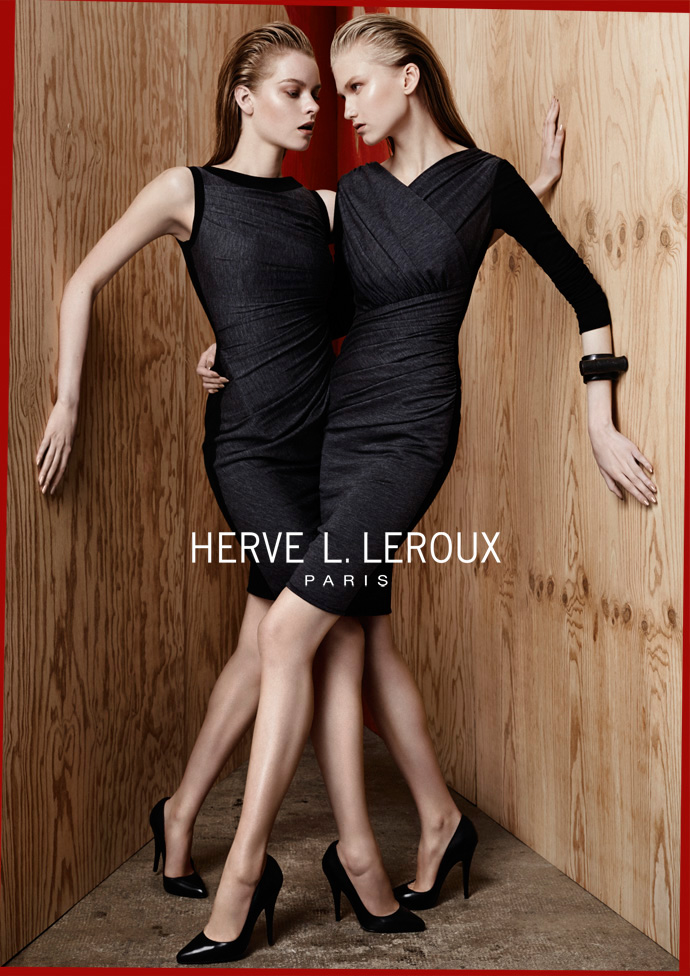 Gwen Loos and Anna Martynova intertwined in slate and black draped front dresses by Hervé Leroux FW2013.
Photography by René Habermacher
Gwen Loos and Anna Martynova intertwined in slate and black draped front dresses by Hervé Leroux FW2013.
Photography by René HabermacherAs you’ve read during our interview and couture atelier visit, Hervé Leroux, born Hervé Léger, is known for his talent for creating garments using traditional tailoring techniques while taking full advantage of developments in silhouette contraction-embracing modern fabrics.
Monsieur Hervé worked as a hairstylist and a milliner before Karl Lagerfeld offered him a collaboration with Fendi, and then Chanel, as a senior assistant. Soon after opening its doors in 1985, Maison Hervé Léger became internationally famous for pioneering the bandage dresses that were about techniques of reforming the body, focusing on the three key words for femininity: curves, waist and form. The “recipe for the 90’s”, as Suzy Menkes once wrote in the Herald Tribune, was about curve-cleaving elastic bandages and a high-octane technique that defied tradition, an effect which Hervé achieved by molding his fabric to the female form instead of draping and cutting it.
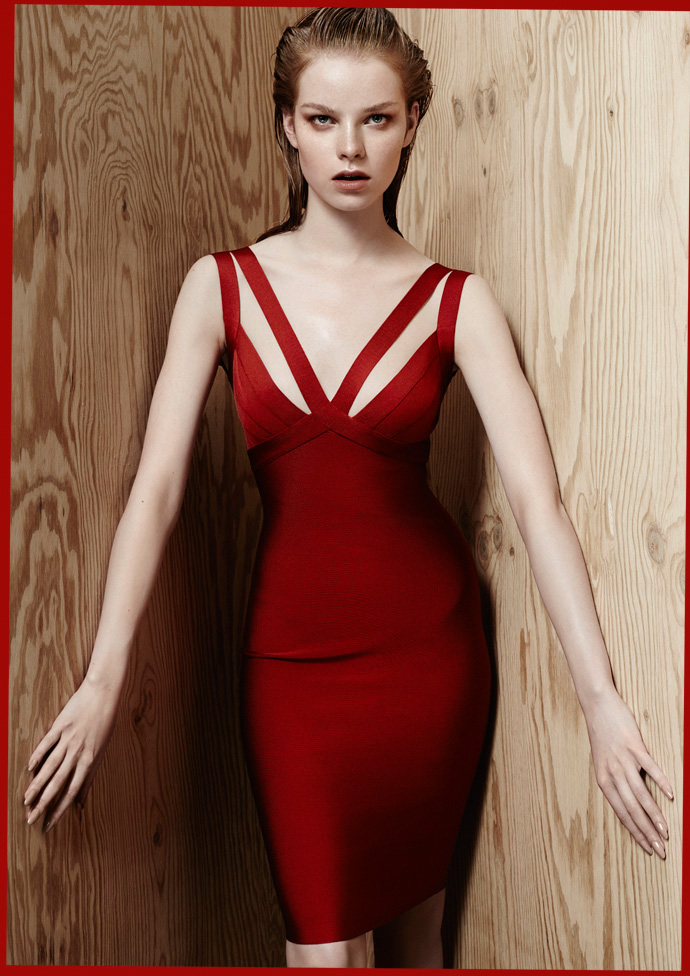
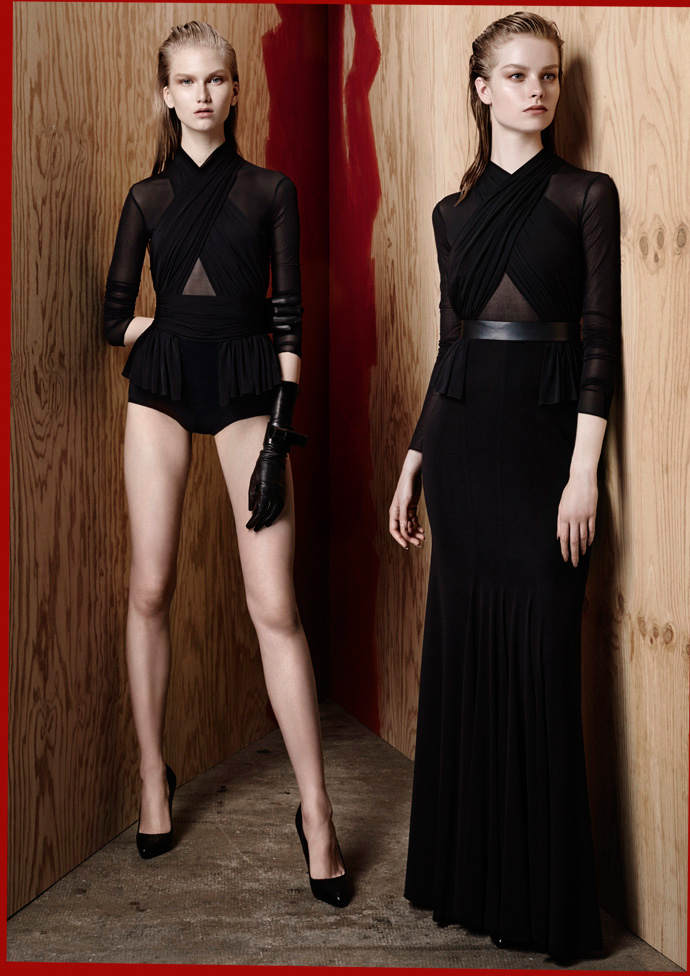 Left side: Gwen wearing a ruby deep double V-neck viscose dress recalling Hervé's iconic bandage dresses.
Right side: criss cross draped black silk jersey pieces. Photos by René Habermacher
Left side: Gwen wearing a ruby deep double V-neck viscose dress recalling Hervé's iconic bandage dresses.
Right side: criss cross draped black silk jersey pieces. Photos by René HabermacherAfter separating from the company which bears his name and adopting the name Hervé Leroux, as suggested by Karl Lagerfeld, Monsieur Hervé recalibrated his vision of glamour, towards a modern sensuality crafted by the hands of a real artisan. Every piece of both the Ready-To-Wear and the Haute Couture collections is created by Hervé’s own hands in his new atelier on 32 rue Jacob.
The Hervé Leroux Fall/Winter 2013-2014 Ready-To-Wear collection is about sober, soaring elegance, reflected on 50 hand-made pieces. For Monsieur Hervé, it is crucial that each piece be as specific and precise as a painting by Pierre Soulages, an important influence on the designer.
“It’s in doing that I can find what I am looking for.”
– Pierre SoulagesThe cut is soft, sensually embracing the female curves, revealing the secrets of the master for both of his obsessions. The fabric is draped only to create luxurious body landscapes on his monochrome canvases, paying homage to the morphology of the body.
Hervé creates a collection that can be referred to as a “second skin” – a fluid, easy-to-move silhouette, which slides on the body, becoming at once feminine and powerful.
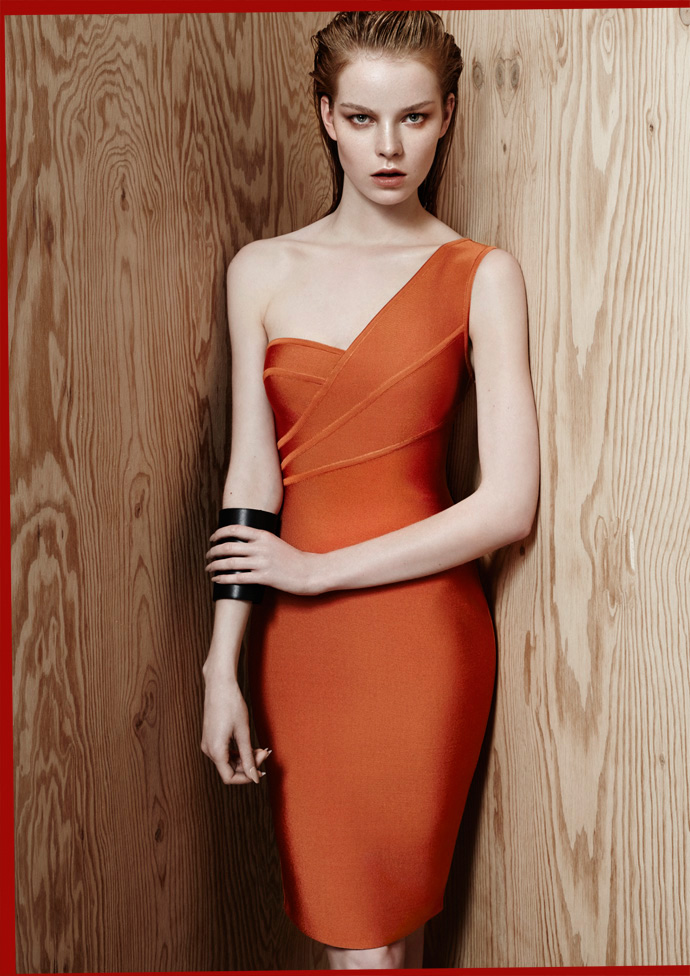 Gwen sports a Pumpkin viscose aerodynamic dress. Photo by René Habermacher
Gwen sports a Pumpkin viscose aerodynamic dress. Photo by René HabermacherCREDITS
Creative Direction – The Stimuleye
Photography – René Habermacher
Styling – Suzanne von Aichinger
Jewelry – Fabien Ifires
Hair – Panagiotis Papandrianos
Make-up – Yannis Siskos
Manucure – Yumi Toyama
Models – Anna Martynova & Gwen Loos – NEXT
Styling Assistant – Chafik Cheriet
First Assistant Light – Laurent Pascot
Capture Assistant – Franck Aubert
Retouching – Dimitris Rigas
Text – Filep Motwary
Art Direction – Antoine AsserafThank you Versae Vanni
-

MONSIEUR HERVÉ
-What’s in a name ?
You can ask Kenzo Takada, Martin Margiela, John Galliano, Valentino Garavani or Helmut Lang – designers who, for various reasons, left the company which bears their name, and then had to make themselves a new name, in fashion or elsewhere.
Or you can ask Monsieur Hervé Léger, the legendary French designer who took fashion by storm with his body-conscious designs, ultimately embodied by the “bandage” dresses. Monsieur Hervé Léger does not design for Hervé Léger, the company. Monsieur Hervé Léger designs for Hervé L.Leroux, a nom de mode suggested by Karl Lagerfeld.

Photography by René Habermacher
Filep Motwary, who met Monsieur Hervé through model and muse Suzanne Von Aichinger, talked with the designer as he prepared his new couture collection for Summer 2013, now on display in Paris in Colette and on presentation in Monsieur Léger’s new but history-laden atelier.
Filep Motwary: So, how is your day so far?
Mr. Hervé Léger: Well it’s cool. I am peaceful today. Yesterday I was not, but today I am.F.M: You are getting ready for your Couture collection ?
Mr.HL: Yes, you see I am a professional, I try to do everything in the right context and I do not like to keep my people working at night and we are trying to be efficient and of course we will be ready on time. You know I’ve been creating for a long time, but because I didn’t want to make shows, my comeback is under new conditions. And it figures that some people always followed me and now I sell worldwide. Business is good now finally again and I am pleased.(As we speak, Suzanne Von Aichinger and René Habermacher are working in the showroom photographing the garments),
F.M: I understand. Do you mind if you help me fill some gaps of your life’s storyline, because it’s out there, but not fully completed… So, it was during the late 1970’s that you started-off your career as a hat maker and hairdresser?
Mr.HL: (Laughs) It’s a crazy story, but… I’ll try to make it short. I had done some studies like everyone, I went as a young man to the Beaux Arts in France though I only stayed for one year as it was the 70’s and France was all about manifestations at the time and intense political changes. As students, we were on the streets demonstrating and I wasn’t learning a lot since everything was on strike.
I also wanted to be independent from my parents and wanted to do something by myself, to work. I am very good with my hands; I am a craftsman and can do everything with them in terms of creation so I decided to be a hairdresser. Although I didn’t study hair, I learnt the job very quickly by opening the door of a hair-salon telling them I wanted to learn. They took me and stayed there for a while. Then I started to make hats, after finding a book at my grandmother’s house, which was full of illustrations on how to make them. The first customers arrived and I was working at home. So there goes the “hat story”.
Then one day someone who was famous in the 1970’s asked me to do a very particular hat, a-giant-sort of “Belle Époque” hat with a lobster on it (laughs). The guy’s name was Tan Guidicelli, whom you probably might know. It wasn’t long enough until he asked me to make three dresses for his show because his atelier was very busy and his show was in three days. Although I had never designed any dresses before, I said “Ok, I’ll do them” and when he saw them he said “ you got a real sense of fashion and you should stop hairdressing and come work with me”. So that was my first fashion encounter.
Of course I dropped hairdressing and started to learn sewing. Later I went into design. My second big encounter was Karl Lagerfeld.
The 1980’s were an easy time. You could easily meet someone. People were more open. Even during my days as a hairdresser, with my friends, you could end up having dinner with Claude Montana, Mugler, Lagerfeld etc. It was not such a big deal as it is today. It was proper dinners you know, not charities. So at the time I met Karl at the house of a journalist friend and something happened immediately. We started talking about corsets (at the time I was fascinated by corsets). So that was on Saturday and on Monday my friend from “Woman’s Wear Daily” called to say “Karl wants to see you.” So I went with a few sketches and he said, “ Well, I don’t care about your sketches, I’m looking for an assistant at Fendi in Rome” and I said “Yes!”.
So by next Friday I was on the plane flying to Italy.Then I went to Chanel for one year and worked for him until I was fired.
I created my own label in 1985 but the bandage dresses came out only in early 1990’s. I don’t consider the beginning of my career started in the 80’s. My career, as I see it started in the 90’s.F.M: Tell me about the bandage dress…
Mr.HL: The real story of the bandage dress is important as a fact of my work storyline. I was having a show at Angelina Tea Salon in Paris, and I wanted something glamorous for the finale. I didn’t have the fabrics. A few days later, I went to a factory and found some bands of metallic yarn, sort of lurex. I asked, “What is this?” and I was told “its for the garbage”. So I took that and I started to put one yarn next to the other and started molding the bands on the dummy, exactly like you do hats. And that’s how the first bandage dress was born. I did the show and it was a success.
I was hooked on these new for me materials and started to experiment. In the beginning, I did not want to put any zippers because I wanted to create a dress with no seams. The problem was that I did make the dress with no seams but when one of my clients got herself in, she couldn’t get out (Laughs).
Then came the presentation of nine dresses in the office of my press attaché at the time. The fashion journalists from American Elle made pictures and became a success very quickly.
F.M: This technique you are working on, the way you make your garments is really one of its kind. Allow me to say that I see them as dresses for women to please men…
Mr.HL: It’s true! Its because they make women look great. The fit is great because it shapes the body. For example, the body of a young girl is not my cup of tea. I like bodies with a bosom, with a waist, curves…
My dresses can give a shape even to bodies that are not perfect. This is why I think men love them the same that women who wear them. They seem almost like a modern corset with no bones. The fit that a woman experiences at Herve L.Leroux is the fit I invented at Hervé Leger. Even in my couture dresses today, I use the bands and my own technique, the one I invented then.
F.M: Hervé, I want to ask you about the true story about what happened. How did you lose control of Hervé Léger in 1999.
Mr.HL: People say that I sold it. That’s a lie, I mean I wish I would have sold it.When the bandage dresses started to be famous, a man that was fascinated by them approached me. He said to me “I went to a party in Caracas and a woman arrived in one of your dresses and everybody went crazy.” He “chased” and sent me some bankers asking to be my partner. Of course I said “Yes” because I wanted to develop this business and I didn’t have to run after any partner anymore…
It was a nice combination and it was Seagram, a very powerful group who invested money and soon Hervé Léger became a major house.
Though I had to be very conscious about the number of sales, otherwise they would drop me. The story is that the guy from Seagram decided to get rid of a few companies they had in order to invest on a bigger French company called Vivendi. At the end he sold everything, including me, although he assured me before that he would find me a new partner and he would help to finance the changes.I had someone who wanted to buy the company from Seagram, they put the dossier in the bank’s hands and then they sold it to Max Azria. So he bought it, though I tried to make it work but it fact it didn’t. At the time I was only left with 5% of the company…
When people invest in a company, especially in the fashion industry, the designer or the name behind the company, has to stay part of it otherwise it won’t invest.Some people like Donna Karan, did it in a very clever way for example.
I guess it didn’t work for me because I didn’t have good lawyers at the time…I didn’t agree with the strategy and they fired me from the house I had created. The worst of it all was that he didn’t know what to do with the house of Léger for a long time. In 2007, which is quite recent I may say, at the same moment when I decided to do ready-to-wear again, he opened the archives he started to re-do my dresses from back then for Hollywood stars and the bandage dresses were successful again.
F.M: And what did you do?
Mr.HL: Wolford contacted me and they asked me to work for them… Then came my shop. The problem was I couldn’t use my name anymore. It’s Karl Lagerfeld who came up with the idea of Hervé Leroux. He said “you’ve got red hair” so it has to be called Hervé Leroux and put the “L.” in the middle, who knows one day you can do again “Hervé Léger Leroux.”F.M: So, back to your collection. How did you start again?
Mr.HL: In 2000 I did a comeback with ready-to-wear and I had immediately lots of customers coming, especially from America. Then came another incident, 9/11. No one came after that.It affected everyone and the business went downhill. That’s when I decided to stop ready-to-wear as it was very expensive to create, have production control, distribution etc… So since then, I focused on Couture until 2007, only for private customers and some shops that wanted to buy a few of my pieces. It was a difficult time but I survived.
It was in 2007 when my customers wanted my ready-to-wear again and it went very good. We are in Colette and so many other prestigious boutiques around the world now. I am very satisfied.
F.M: You are a designer that works with couture methods, a real artisan. How do you see the use of “future” references and approach in fashion in combination with technology?
Mr.HL: I think moving towards the future is good for this business, generally speaking..Sewing a dress is always sewing a dress.
For me what is more important is that the clothes look good and made with good materials. I know nothing about technology whatsoever. I know that my clothes are very true; I use very particular techniques to make them. I am more of a couturier rather than a stylist. I don’t go scouting for old clothes to re-do them, I don’t search for ideas around. Even at moments when I wanted to copy someone, I just couldn’t do it you know?Other’s people’s clothes don’t inspire me. I am obsessed by my own ways of creation and I feel lucky to have customers starting from 16 to 70. I am never about trends; I see no use in them. Today I have the feeling that it is all about money. Designers today don’t spend hours fitting a dress on a body. They do it on dummies. I feel comfortable with the way I work.
F.M: How were the 1980’s and 1990’s fashion scene compared to what we see today?
Mr.HL: Oh my God, things were so happy back then, so happy. The 70’s, the 80’s and the 90’s. People were passionate and they could make money from that passion. Bankers, investors or whatever you call them didn’t really exist then so designers were freer. Only one thing Filep, the aesthetic of the girls then is what is missing from today.Or the power the shows had back then. Think of Montana and Mugler!! Oh my God, the girls were so beautiful, the way they walked. I feel lucky for living through that era working with all of them; from Linda to Cindy… I had them all.
And they were so full compared to today that everyone is so skinny. And all my models loved the clothes; you know a lot of clothes would disappear after the show (laughs). Even during fittings those girls would feel the clothes, they were posing.
Today my favorite show is Victoria’s Secret because it’s a happy one. I am not saying girls are not beautiful today, I just think shows today have become boring and less inspiring. They look like robots and there is no charm. I really wonder if I was to do a show today how I should do it and not look ridiculous and dated.
And sometimes I speak with journalists and they are bored of the current situation too.
Anyway, I am not ready to do a show now also because I am not a kid. If I do a show it has to be made the right way as a good show also costs a lot of money.F.M: Maybe you could do a little show in a Hotel Suite like couturiers used to do back in the 50’s.
Mr.HL: Hmm, yes. For this season I just wanted to show the work the way it is. Starting on Monday, Colette will have 5 of my dresses in the window and on Thursday I am showing another 12 pieces in my showroom as I have been invited by the Chamber of Haute Couture and it feels wonderful.F.M: What is this collection about?
Mr.HL: You know I never start saying “I’m going to do this and that”. I just grab my fabric and start working. All I can say is that 80% of the collection is done and it looks like a walk in a Japanese garden. The drapes are very graphic in the sense of Japanese design…F.M: Why does couture still breath? Is it merely a question of tradition? Why does it still interest people?
Mr.HL: It’s exceptional I would say with an excellence. Although the world has changed and we are in the middle of a crisis, luxury is always surviving. What is luxury about today is another story than what it used to be. There are a lot of luxury houses that produce clothes or bags in Taiwan etc. but, there are still women who want to dream. I see my clients… And the movie stars I dress – of course they don’t buy the clothes (laughs).There are still women who are not in the spotlight, not in the newspapers yet they prefer couture because it is special. They are in search of the perfect fit and for me the fit is something important.
F.M: Why is couture so personal as it requires the customer and the designer in a very private session?
Mr.HL: There are less and less couture houses as time goes by. Chanel is a real Couture house for example because they have the right hands to do the artisanship, Gaultier also as well as Dior. Couture has a certain way of doing it, it has its own rules, and also the fabrics are richer. Everything is on made on perfect scale. There are more and more rich people and the opposite, which I find very depressing. We can say there are people who are rich today and they are richer than what the term “rich” meant 20 years ago..
Those who spend, really spend…F.M: What provokes the strongest emotions in you nowadays, compared to what made you emotional in the past?
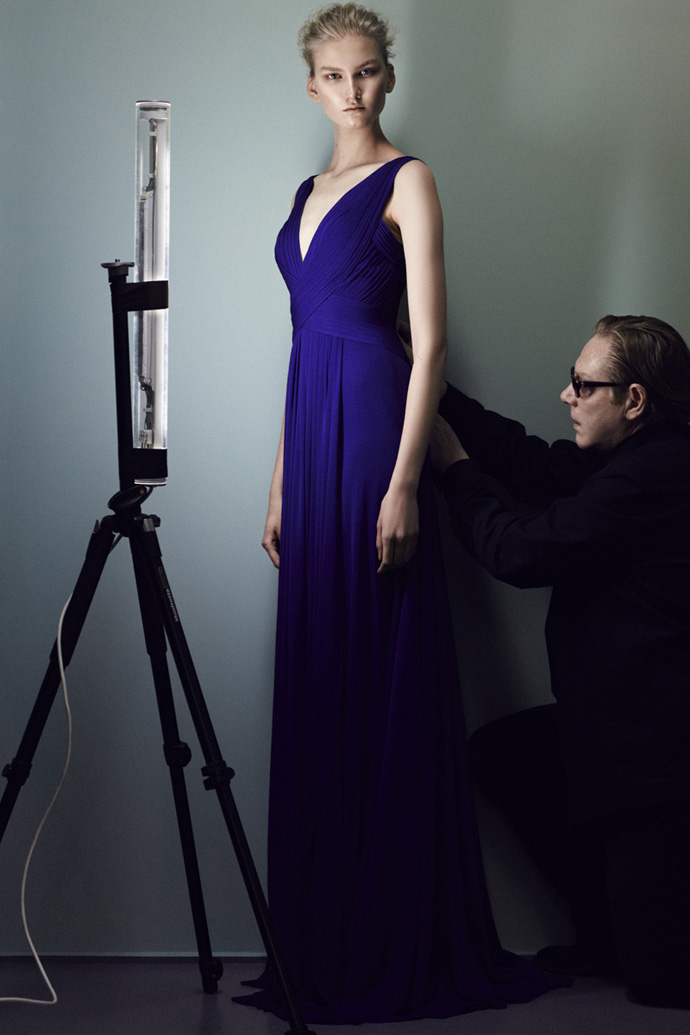
Mr.HL: When I was “Hervé Léger” I was never satisfied. Nothing was good enough and I always thought I could do better. Today, although I still want to do better I become emotional by looking at my own dresses, a feeling I never had before.
I am happier today because I don’t have anybody else involved in my business; I have a great team of loyal people working with me. Also what is very emotional for me is when I see women trying my clothes on.F.M: What is next for you?
Mr.HL: I’m working on developing my business. A perfume that I am working on. I want to start doing accessories, shoes, lingerie and swimsuits. Also my customers locked me in my atelier designing dresses – at least I am famous for something (laughs)- but you know I am very good in designing suits, coats, pants and blouses…Basically when you are wearing Herve L.Leroux, is for the evening. I want to make day-wear too. Although every time I do they never buy it, but I’m going to push.
The interview is a collaboration project between Un nouVeau iDEAL and The Stimuleye.
interview FILEP MOTWARY
photography RENE HABERMACHER
fashion editor SUZANNE VON AICHINGER
hair PANOS PAPANDRIANOS
make up YIANNIS SISKOS
model ANNA MARTYNOVA@ NEXT MODELSthank you VERSAE VANNI @ NEXT PARIS
-

face 2 face : rad hourani & filep motwary
-Just before leaving for some much needed holidays, The Stimuleye is happy to announce a new interview series in collaboration with Un Nouveau Ideal’s Filep Motwary.
A-referential, Unisex, Anti-Trend, Feature Film… wunderkind designer Rad Hourani is first to go FACE2FACE.
Creative Direction: The Stimuleye
Assistant: Jean-David Alimi
Sound Design: SOSSOON
Thanks: Robin Meason / Creative Door.
-

films of the season: monsieur chypre – a short film with erotokritos
-The Stimuleye is proud to announce, with the support of Vogue Italia, an “erotic fashion epic” : Monsieur Chypre.
“HE KNOWS WOMEN, AND WOMEN KNOW HIM”
Erotokritos, it’s a strange name for a fashion brand.
It’s an even stranger name for a person.
And yet, he is truly called Erotokritos Antoniadis, named after the main protagonist of medieval epic poem, a hero “born from the labors of love”.
For 15 years, his label has been seducing women of all ages, drawn to collections that go back and forth between the sophistication of Paris and the dolce vita of Cyprus…"come and get it."
“THEY CALL HIM MONSIEUR CHYPRE”
France and Cyprus, Paris and Nicosia, it’s a long-distance couple.
In Monsieur Chypre, by Antoine Asseraf & René Habermacher, they come to life:
Loan Chabanol, channeling the nostalgia of Marguerite Duras’ The Lover, plays the tormented Parisian woman, cracking at the surface,
while Constantino Kouyialis, in his first first on-screen role, is a revelation as the seductive eponym hero, a modern day Alexis Zorbas.“AN EROTIC FASHION EPIC” we call it.
“Erotic,” how could it not be with a name like Erotokritos ?
“Fashion,” of course: stylist Michaela Dosamantes, fresh from winning Best Fashion Award at La Jolla Fashion Film Festival for La Main Dans Le Sac, mixes the season’s classic looks to capture the heroine’s transformation from “bluesy” in Vuitton to “red-hot” in Valentino.
And “epic” ? What else do you call a fashion film 10 months in the making, taking place not only in Paris but in numerous locations in Nicosia, in the salt lake facing the Hala Sultan Tekke mosque in Larnaca, in the Almyra and Anassa deluxe hotels, in small taverns by the side of the road, or in the majestic monument carved directed in the stone, the tomb of the Kings in Paphos ?“HIS VOICE IS A SONG”
All this, to the original soundtrack of Lori Schonberg and Shane Aspegren, members of Ça Va Chéri.
(Download it here).So, now the tough questions.
Is Cyprus really like this ? A little bit. Not at all. It depends how you look at it.
It is an island of freedom in the east mediterranean, where couples from Israel and Lebanon come to escape religion. It is the birthplace of Aphrodite. You go, you decide.So how can I meet this Mister Cyprus ? We hear that one a lot. From women (and men) of all ages. Maybe he’s real, maybe he’s a figment of our collective imagination, our repressed desires. One thing’s for sure — we can’t give you his number.
“ATTEMPTING TO CHARM HIM IS USELESS. HE IS THE ONE WHO WILL FIND.”
-

MARIOS SCHWAB
-MARIOS SCHWAB TALKS TO FILEP MOTWARY
PHOTOGRAPHS BY RENE HABERMACHER
Marios Schwab is known for his unique interpretations of natural forms and his ability to dress the female body in a way that he only knows.
While the world of fashion turns its attention to ephemeral trends, we decide to interview Marios and hear him analyze the Schwab philosophy, his position at Halston and the analysis of his very first Resort Collection, one day before its revealed to the public and press.
His collections are based around reflecting the inner structure of a garment on the outside, a theory that helped to define him as one of London’s most exciting designers – a position he continues to hold.
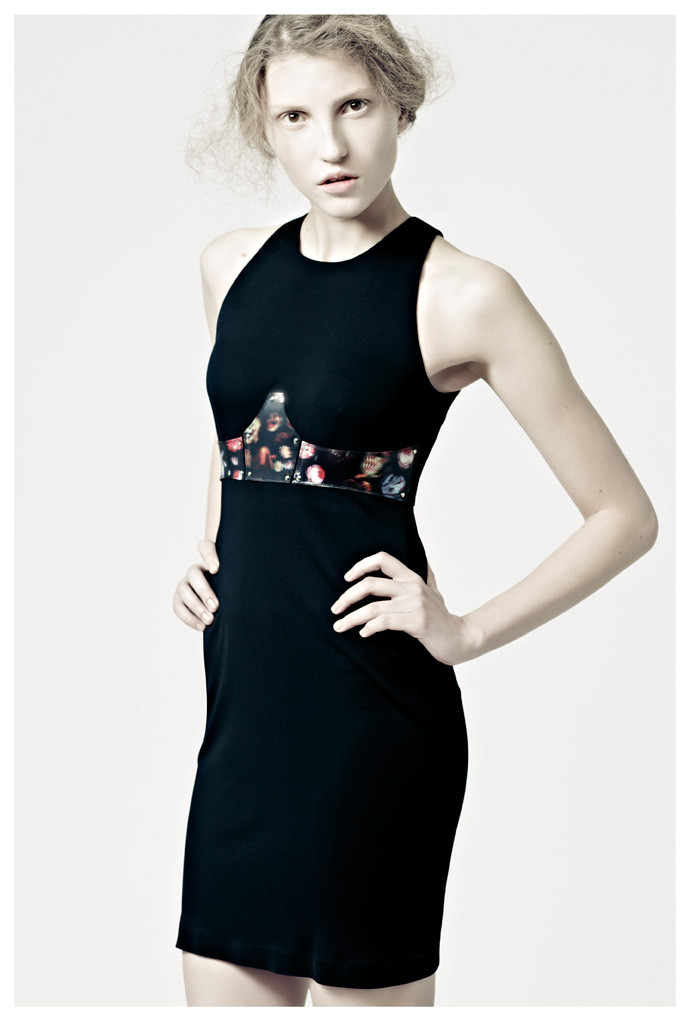 Marios Schwab resort collection 2012. Photography by René Habermacher
Marios Schwab resort collection 2012. Photography by René HabermacherA distinction and Best Student Award graduate of Esmod, Marios moved to London in 2003, where he completed an MA in Womenswear Fashion at Central Saint Martins, studying under the guidance of the formidable Louise Wilson.
Two years later 2005 saw him launch his own label, showing for two seasons with Fashion East before making his on schedule debut at London Fashion Week for SS 2007
Since the Spring of 2009, he was appointed as the creative director of HALSTON in New York.
Schwab’s designs are sold all over the world, in shops ranging from Dover Street Market, Harvey Nichols and Browns in London, to Maria Luisa in Paris and Barneys in New York.
Photographer Rene Habermacher met with him in London for the creation of the pre-collection’s look book
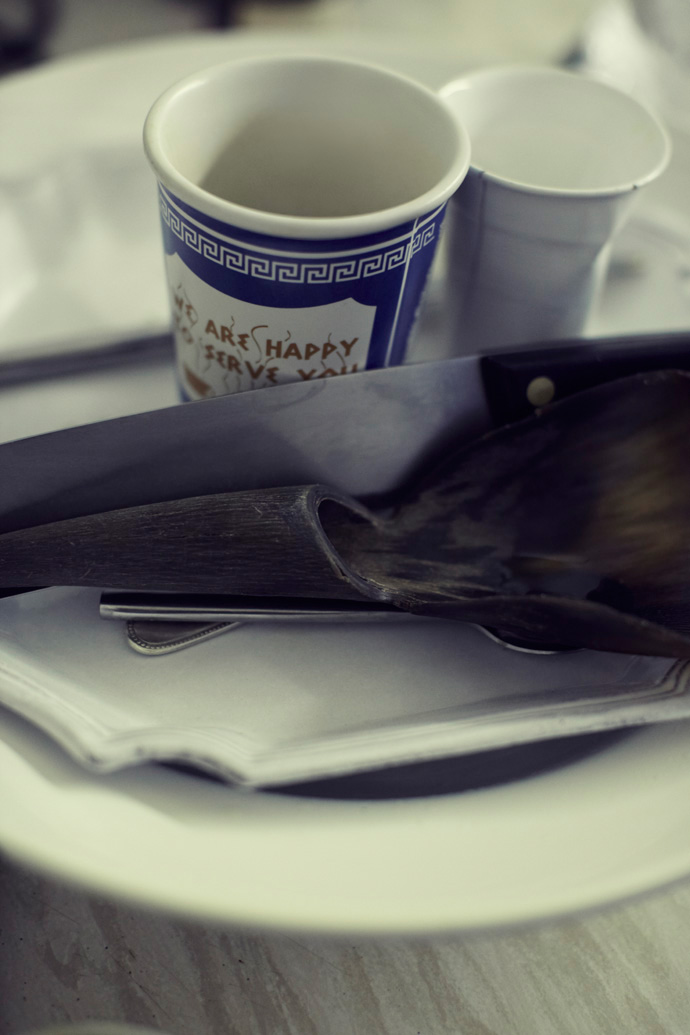
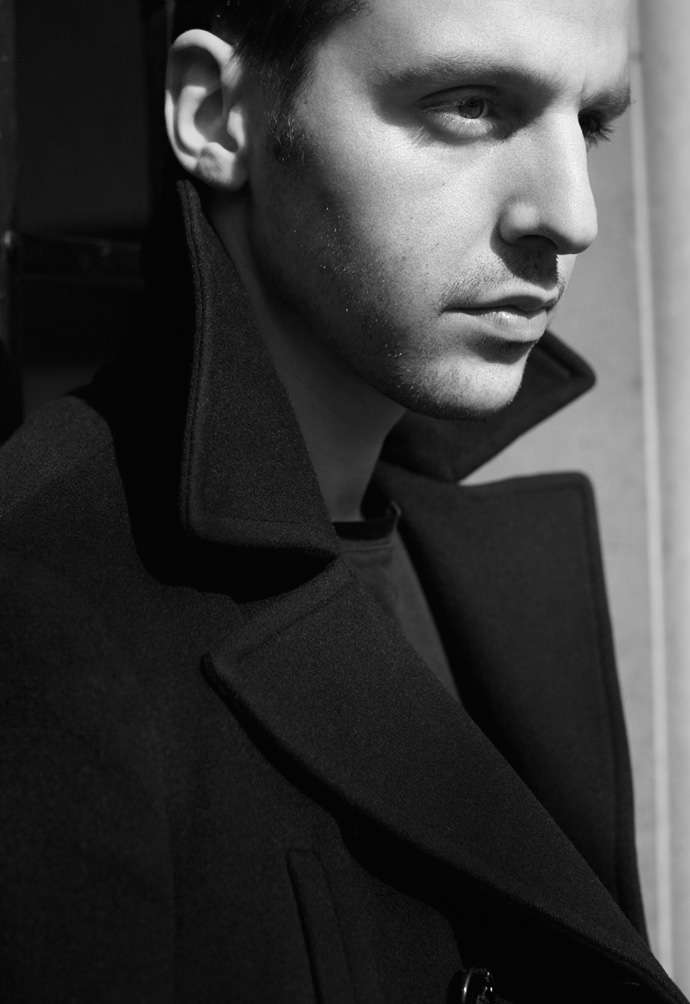 Marios Schwab and his Greek coffee set at his studio. Photography by René Habermacher
Marios Schwab and his Greek coffee set at his studio. Photography by René HabermacherHow are you today Marios, what have you been up-to since this morning?
Pretty much like I came from Paris and immediately started working on the main line…It’s a non-stop situation right now because I just did my first resort collection which was in a way an experiment in terms of getting in right with timings and deadlines, a completely new experience for me. Also we are producing this collection elsewhere outside the UK.
You just photographed your first pre-colection for Summer 2012 yesterday with Rene Habermacher?
We started shooting on Friday; he came over to London and shot the collection in my Studio.
What is your pre-collection about?
I went to Vienna for a weekend where I visited Kunsthalle and saw these amazing series of Vanitas paintings from Dutch painters. For me they always have this feeling of seduction and mysticism that I really like and the hide-reveal again which I am so obsessed about. I wanted to create a print that kind of works color but still within a black background…
It all started with creating the print with artist Tom Galland, who is a friend living near by and with whom we work on numerous collections together. The outlines pretty much echo shapes that have a classic sort of detailing from Maris Schwab, torn down so it becomes easy to wear and accessible for the younger girl that wants to buy, but not necessarily can afford. It’s about clothes for someone who doesn’t want to wear something that is too tailored.
How did you decide to add a pre-collection in your work? Was it after popular demand? What it the aim of a pre-collection anyway?
Yes first comes the “demand” as you said because the main line concentrates on tailored pieces, cocktail pieces mainly, and has the element of fabrics that are more sculpted. There was an easy-wear-feeling missing. You know, easy things that make more sense in a resort collection rather in a mainline. Fabrics like jersey, which is great to wear, in a good quality and good price. Its something that was requested from the top floor but also the feeling of having to return back to something that is a little bit younger was very very important to me.
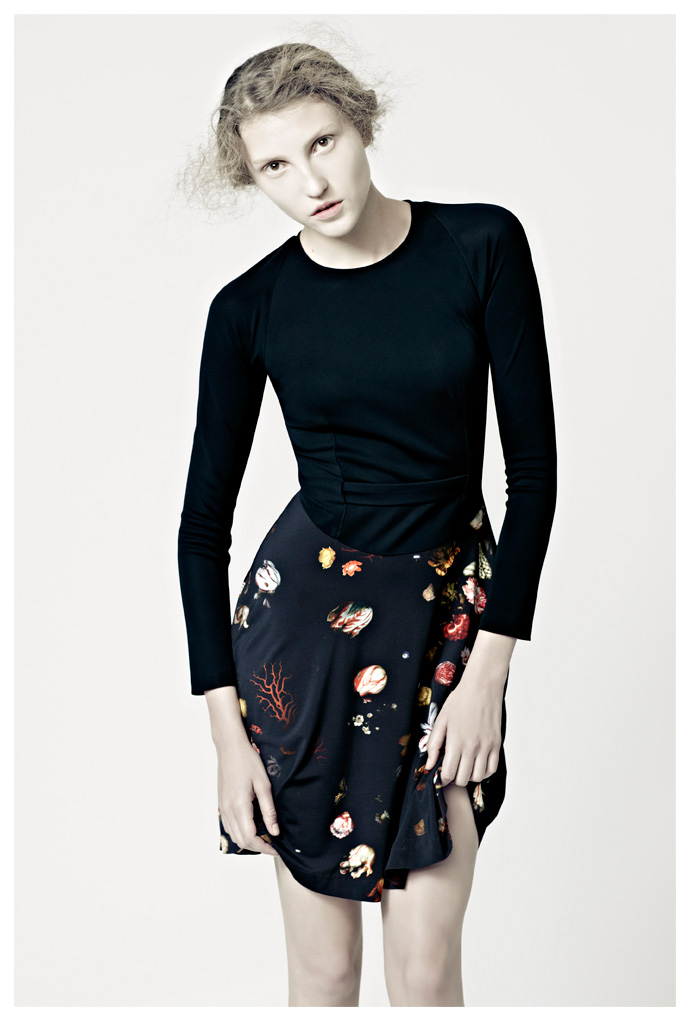
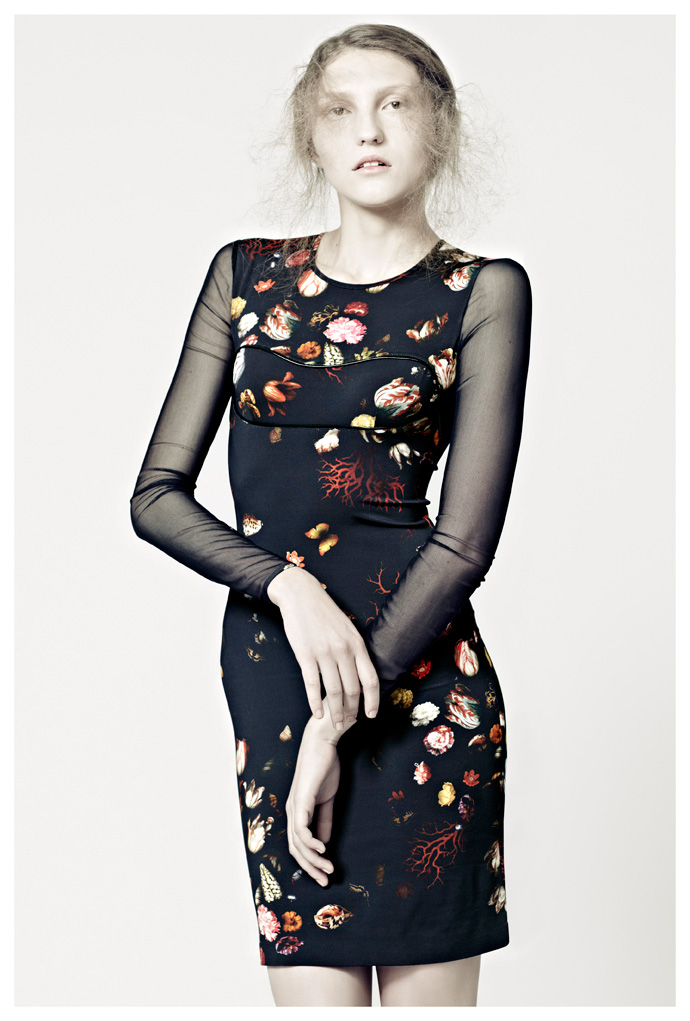 Marios Schwab resort collection 2012. Photography by René Habermacher
Marios Schwab resort collection 2012. Photography by René HabermacherHow is this collection pricewise?
Well it starts from 200 GBP and reaches s 750 GBP. That was the main point, to put very interesting detailing from the DNA of Marios Schwab-keeping the outline and fit on a friendly price. It is quite an interesting thing to do I guess because when you start a collection with this thought pros-mind-set becomes automatically an interesting project. I was concentrating on dresses that you can put on daytime and also in a club or to go travelling with and I think this is something I would like to concentrate on at this point and turn it as the signature of the resort
Marios, it often seems that you manifest an idea way ahead of its time, even two seasons before others pick your ideas later. How do you work, develop these ideas and where you withdraw your inspirations?
Well it’s a lengthen process because I always like to bring in the surroundings of my own life, or what I hear in any sense politics, stories, everyday life, as its an emotional story developed into garments. I don’t know how to explain it really. It usually starts with materials and then it develops into proportion and sectioning of the body in a certain way.
Last season how it started for example, was after a documentary I watched about ancient Greece and the oracle temples. There was this amazing building- I don’t remember where it is now-but it was saying that “nothing in excess.” And it kinda gave me the idea that basically its very much about what we are right now: overloaded with information but also we want so much out of everyday life, some can afford it, some cannot. For me, the process of it was to take this theme and create something that is beautiful with craftsmanship.
So I started reading essays about craftsmanship, then I came across the work of Adolf Loos, an architect from Austria who worked on finding the meaning of decoration and its meaning in society.
To cut the story short the collection was based on minimized craftsmanship and how it becomes an over precious part of each garment. So really framing the details on specific parts of the body that becomes precious at the same time.
I like to place things where they don’t belong from time to time. Broking was one element but also the status of symbols like a pearl necklace and how it can be re-translated in a modern way. Within this season, the Vanitas paintings for me meant life, beauty but at the same time possessions and darkness. It’s so beautiful and it reminded me of Victorian wallpapers, bursts of flowers with a dark background. All these harmless detailing in the collection like elastics that wrap around the body and create the draping reminded me of my earlier works since Spring Summer is very much about the inside outside, how you can retranslate draping without looking like a retro reference, you add a utilitarian element to it but then it’s a little bit more modern.
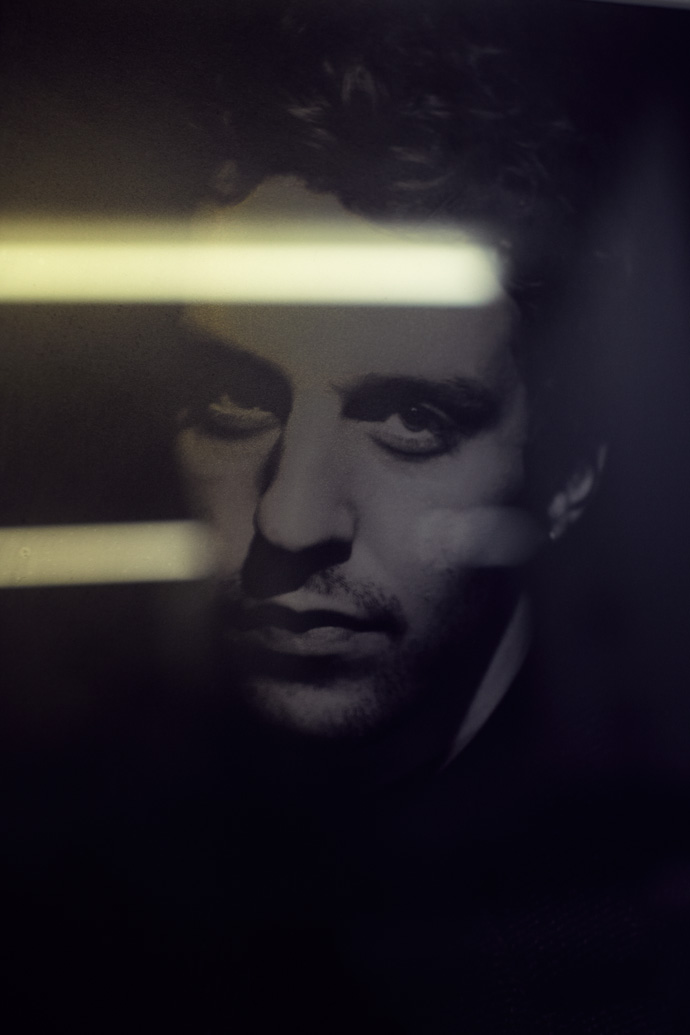
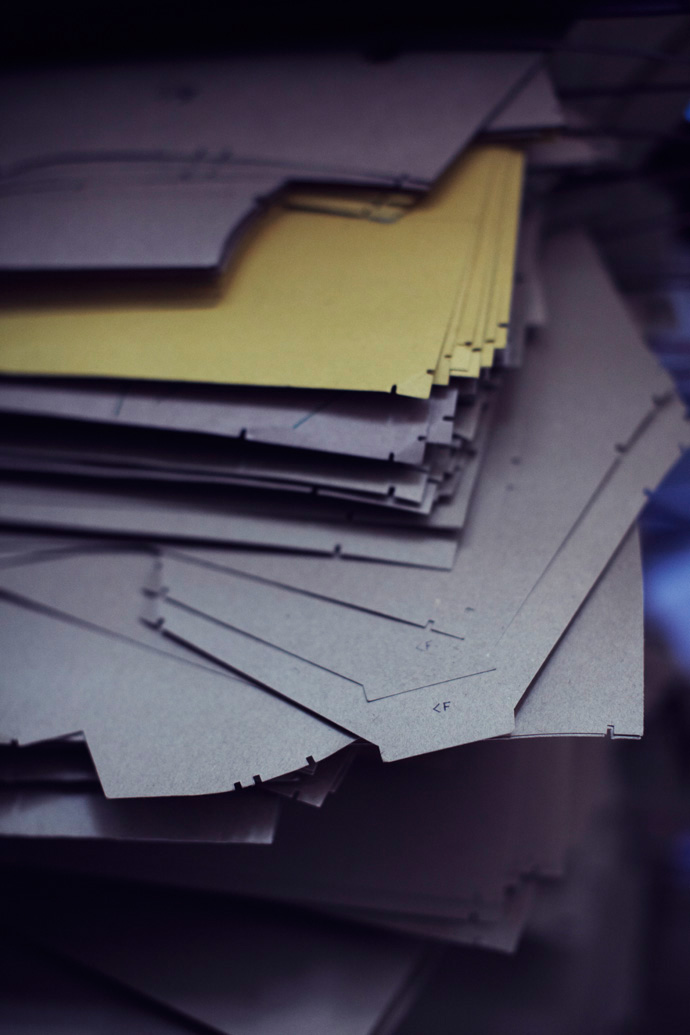 Vintage print of Marios portrait by Paolo Roversi, and Patterns at the studio. Photography by René Habermacher
Vintage print of Marios portrait by Paolo Roversi, and Patterns at the studio. Photography by René HabermacherIn the last five minutes you used the word “craftsmanship” for more than five times. How important is craftsmanship in your work?
It’s the most important thing for me. The way I learned the trade was going to Austria at the age of 15, surrounded by manic women, teachers that knew everything about traditional techniques, probably not very used these days unless of course you work for a couture house. It became my obsession and also something I am very much fond of. I like the humbleness of a craftsman and the sound of craft. I feel so comfortable sitting next to a person that is s specialized and so focused into his work. There is certain romanticism in it that I always go back to. I like sitting in a studio surrounded by the fabrics I just got from the manufacturer and then turn them upside down doing things I didn’t even suspect. I get a kick out of it, not to buy something that is finished but apply something to it.
I guess that can be said about women or the girls that inspire me. It’s a woman with personality- I don’t like women with no character. I don’t see a woman only as a body to dress. I see her as a strong persona that has a little bit more that just attitude. For me, women should be running the world at this point.
I like women who are intellectuals and private at the same time …I make a subtle story each time for them that does not overload their personality, enhances their personality.
While having a closer look at your past collections, I noticed that you continue to focus on the women’s body structure, emphasising on the waist and shoulders. Though now, your work has become more confident and much more strict than before…Do you agree, how do you see your work through the years?
Basically the starting point of a collection is always a naked body –in that I draw around the bodylines that are very much continued over the years I have been working. Whenever I dress a body I like to reveal what I also hide under a garment. From an architectural and proportional point of view it’s the most interesting part for me. What you cover you can reveal in a very sophisticated way on the surface of the fabric but also the cut.
There was certain toughness in your winter 2011-2012 collection with the use of leather and all…
The winter collection indeed had a feeling of toughness and that’s a classic element I guess in Marios Schwab that contains this femininity within something that is the good girl and the bad girl together. There is the prettiness and a sexual element within something that is sometimes quite strong and tuff. And I like to mix leather in a sense that you take the lady completely away from clothes. I don’t like ladies. I like to have a non-pretentious woman and I think that when you look closely to the garments you can see that they are not pretentious and that’s very much about the aspect of Schwab. My dresses need to be appreciated close by and I like that they don’t scream aloud but at the same time with a closer look you learn to appreciate them, their line and the detailing.
Taking elements that are very lady like and gentlemanly, for instance the broking and the pro necklaces kind of annoy me when I see them on women cause they are just too preppy.
I use them in a way that they become almost irrelevant of their status, hidden behind seams or they grow out of a seam either the are attached in a different way and become a utility, not just decoration. This is something I like doing also, using decoration at the same time in a functional way.
Remember the metal piece from an earlier collection of mine? The point wasn’t to create something shiny with a reflection in order to simply impress the guests of the show.
I thought of it as a garment that gives you this extra support when you dress up and feel you are wearing “something”. Psychologically, in some dresses this is missing, also in fashion these days. People used to take time to prepare themselves, so I tried to modernize this vintage routine within this shiny dress.
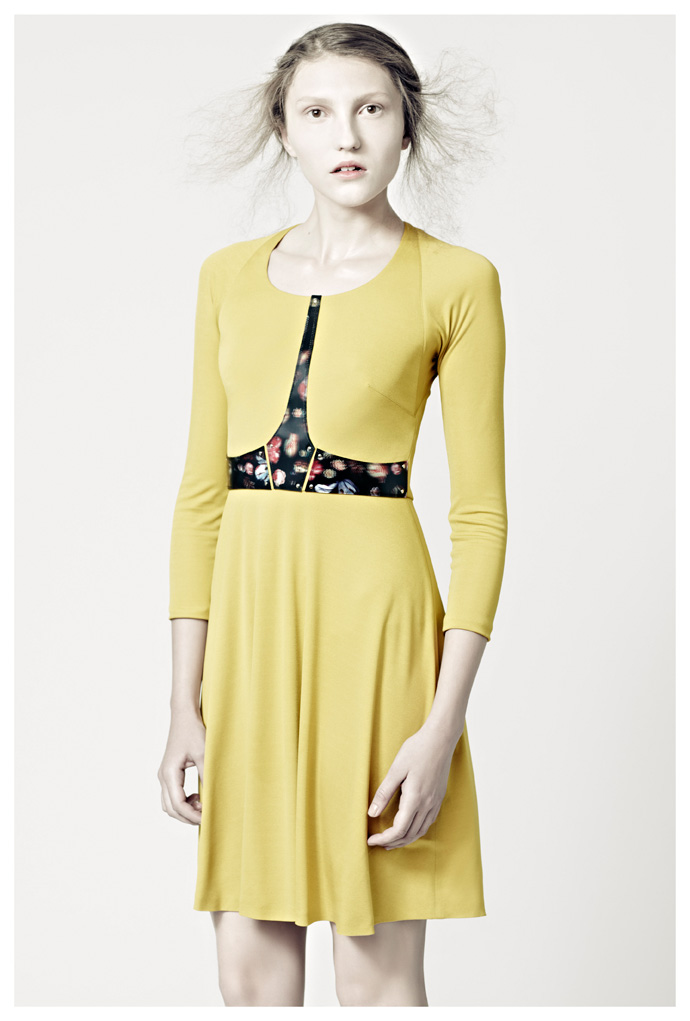
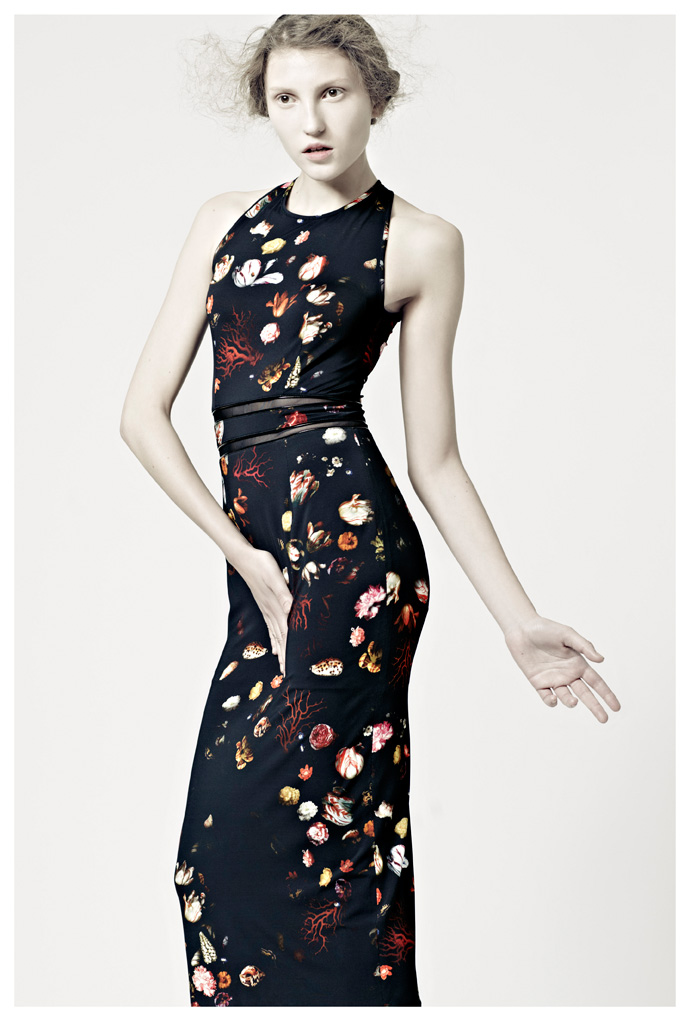 Marios Schwab resort collection 2012. Photography by René Habermacher
Marios Schwab resort collection 2012. Photography by René HabermacherHow has your involvement with Halston help your own brand you think?
I think it is such an interesting thing to work for another brand, with another team, travelling in a different country to produce a collection, which proved to be such a precious part of my Halston commitment. Basically you have a team that works abroad, that you are not very close to most of the time, you have different deadlines than your own. All these made me feel much more strong. You know also since I am the only designer there, I don’t have a team that designs alongside me which is exactly the opposite from what happens at Marios Schwab. It surprised me quite a lot. I always thought that it was going to be hardcore, working for two brands at the same time. It is hard but not as difficult I had in mind it would be.
Crazy in what sense?
Meaning the sense of “switching off”. I was surprised on how I could switch off from my collection, going to Halston do something else and then back again and back again… I felt a little bit scared before taking the job. It’s indeed a huge responsibility but you learn to do it, that’s it. Its pretty much like “you have to get on with it”!
What made Halston such a rarity as a House?
Halston as you know was concentrating on enduring fashion and I’d love to see Marios Schwab doing that,..
Halston encloses a story behind it that you can always see something else if you try looking closer. At his time Halston was creating, he offered something that was a very subtle, a minimal way of looking glamorous by wearing something simple and yet looking beautiful and seductive and expensive and clean. He had a very modern way of making clothes. The principle probably is the attractive one, what it was all about. But it was also attached to Studio 54, a very special place of that era and it was in everyone’s expectations. People just love it and for them Halston is attached to Studio 54.
Do you think your customers understand you better than your critics? Also how do you respond to bad criticism?
I don’t read reviews anymore because it just confuses me. After a show you are very tired and very emotional and personally the last thing I want to do is read criticism, good or bad. One critic can lift you up or drag you down which sometimes its not very relevant to a person that works in a very personal way and in private. I go meet people, the consumer, and the woman who wear what I create. You want to hear both at the same time, it normal but when you are still conquered by the after show adrenaline, you can’t just bother with that.
You belong in the Kane, Katrantzou, Pugh and Pilotto generation. It’s somehow like the “Antwerp’s Six” story. What in your opinion, all of you offered in fashion that was missing at the point you appeared?
I think quality, good fit within something that is very special and still acceptable and wearable. London at the time was about things that were more phantasmagorical..
So you are saying that you guys made the difference?
I’m not speaking about the rest, but yes I think that was what was missing at the time without pointing out someone specific.
Let me do that (laughs) all you have to do is agree or disagree (laughs). You all came at a point where as you said everything was very phantasmagoria and finally we had some wearable clothes coming from London, which was not the case before.
Yes, London started having a good balance. More than anything, the overall look was a little bit overwhelming. But I have to say that London is very special on that and supports all kinds of new developments, new ideas in fashion. It has to be said; you can’t really find that anywhere else’s in the world. Many people wonder, “What’s this thing about London, anyway?” But its true, London within this experimental nonsense or sometimes good sense it creates certain movements and in a way creates the platform for all of us to stand onto tomorrow..
What would be a designer’s weakness you think? What’s your weakness in that case?
Deadlines (laughs), free time. I can never organize myself to have a life. In this business you become very critical about what you do. It’s the mentality of living in your own bubble, creating for somebody else can be quite intimidating at some times, for others as well..
How difficult is for a designer to cross lots of different ages in one collection?
It’s a matter of confidence of the client. If you see a curvaceous person that wears a skin-tight garment, regardless of her age, whether she is a young girl or a woman and she has the confidence and attitude that matches the whole personality and appeal its instantly a success. This equals that the designer must have done something right.
Would you tell a client if she doesn’t look good in your dress?
Yes if she would ask me I would definitely tell her my opinion. If she didn’t, then why I would I tell her if she is happy with it? It’s her choice and one needs to respect that.
How do you see the present of Fashion?
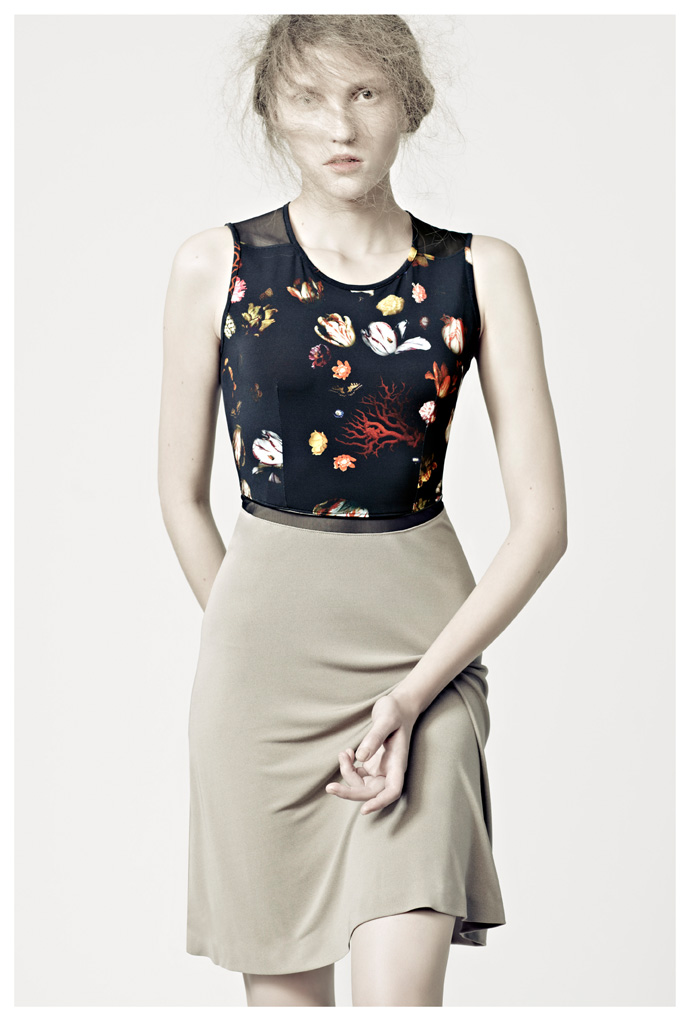
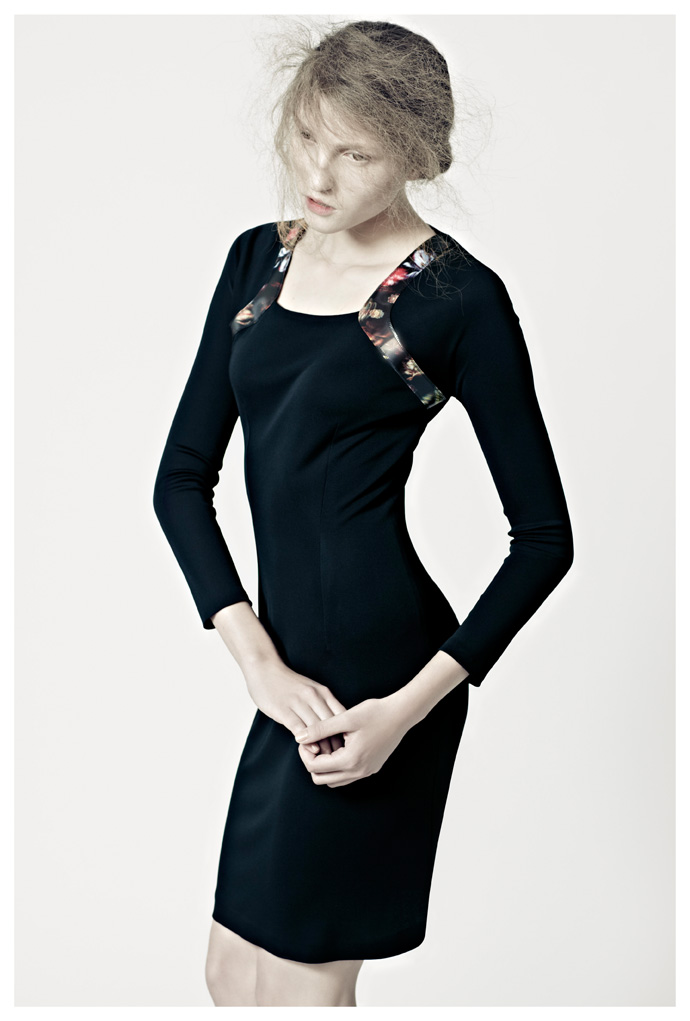 Marios Schwab resort collection 2012. Photography by René Habermacher
Marios Schwab resort collection 2012. Photography by René HabermacherShall we move to the next question? (Laughs). It’s interesting because it’s changing and its not changing at all. I think what changed is the way we get informed, how we advertise, and talk about things, how we buy things.
Everybody has a question mark about what they are doing these days…
The non-interesting part of this global change is throughout this financial downhill, the how quickly we gain information around us can make things very boring and very …
Things are supposed to be fast in fashion and although it seems that way, there is no new development in music and so many other creative sectors; and that is a shame because people stopped thinking unnaturally and they want to get into so many different characters since there are surrounded by so much information and don’t know how to handle it. They don’t have the time to study the new, see it from a distance, observe it, analyse it. It’s not a concrete period, there’s no certain opinion about things. You want to dive into so many different things because you have no other option.
It takes one bad collection to take a designer out of the spotlight you think?
I don’t know how it is but I wouldn’t see it that way I don’t know. You can have a bad collection because you decided to go on extended holydays and have a bit of a life.
Its interesting to mention that fashion can be such a fluff in the air. People think Balenciaga is amazing and next season they think Givenchy is the most interesting thing…sometimes it can become a little…I don’t know how to explain.. Do people have an opinion at the end? In previous decades or centuries this wasn’t much the case. Things were very specific. I’m talking about how people dressed, the way people reacted on fashion, art, their opinion…It was about dressing up your own way, to look pretty your own way and the way they looked upon things. Its not about buying the total look its about buying items from a collection in order to combine them with what you already have and make your look your own.

 Marios at his favorite afternoon stroll and part of his butterfly collection. Photography by René Habermacher
Marios at his favorite afternoon stroll and part of his butterfly collection. Photography by René HabermacherYou own your own company—nobody owns you. How’s that for a responsibility considering the reality of the fashion houses today?
I don’t think it’s necessarily a bad thing, no. The point is that our times as it is, its quite difficult to increase your team members, the structure, to tap into things you always dreamed of, like the way you want your company to spread out…
It’s not easy to do it by yourself without investment, or being helped by another source. It would be a shame to only be able to create clothes and not a whole product, that doesn’t only concentrate on fashion, not being able to communicate it right. Sometimes you don’t have the time or the money or both. But help must be welcomed.
I am curious to know, how many people work for you?
Hold on I need to count…Five full timers, mainly administrative and office work. I have one assistant that concentrates on fabrics and the boards.
Do you give chances to interns?
YES!! Yes!! Interns are so important, I like teamwork and when I refer to the team as always say “we”. It’s confusing for people. Who’s “we”?
I see myself as a craftsman, as I said before, I like to work within like a team that creates something that needs to be educated to us , to find our how its done and how its made and it takes a team of people that are special and committed to do that .
You can drive people crazy when you just give directions and not get involved in the making with them. For us especially, as we make all the samples in-house and it can get a little crazy. Students and the team that is here for years working with me seems like a family, we get emotional and fun and relaxed at the same time.
What I want from a student is to learn something special while running around in all the sections of the company, doing things, the boring jobs even,.. They need to have a complete idea on what it takes to be a designer because their time will come to open their own business.
Fashion is not a fantasy nor a party…
Do you ever let yourself go? Is there anything in your personality that you really have to keep a tight grip on?
The most important thing for me is family. They are part of what I do. My dad and mother enabled me to leave home at 15 to do what I wanted to do, feel free. They are critical about my work, which is very very important for me. Sometimes my mom doesn’t like certain things as she is a woman with style and she was the first who gave me the inside of quality and aesthetics.
In my private life I collect images I find beautiful. I like a variety of things, I love the impactful emotion when I sit on a beach somewhere in Greece, or sitting with old women on an island’s quiet little street, hearing them talk …Easy things and simple like that…
I like creating through emotion and experiences, history, the women I met n my life, their attitude, character. It can be very cinematographic. I build up a whole fictional character, created from my acquaintances with different women throughout my life.
What was the last thing that Stimulated you?
…my boyfriend..
-

SIREN SUZANNE von AICHINGER
-Suzanne von Aichinger is a modern archetype of the Parisian muse, in spite of the fact that she was born in Germany, and grew up in Canada.
She was discovered by the legendary illustrator Antonio Lopez, whom she considers to be one of the great influences in her life, as well as a very close friend. She inspired and collaborated closely in the design studios, with Christian Lacroix, John Galliano and Jean Paul Gaultier. Suzanne von Aichinger posed for iconic photographers Serge Lutens, Paolo Roversi, Mario Testino, Jean Loup Sieff, Ali Madhavi, David Seidner, and strutted down the catwalks of Yves St Laurent, Thierry Mugler, Claude Montana, Gianni Versace, Christian Dior (Galliano) , Hermes, Martin Margiela, John Galliano, Jean Paul Gaultier.
In Greek mythology, the Sirens with the irresistible charm of their song, lured mariners to their destruction on the rocks surrounding their island..
In modern mythology, Sirens are dressed in Rick Owens, pose for photographer René Habermacher and share their secrets and thoughts on current and past affairs with Stimuleye Filep Motwary…
SUZANNE VON AICHINGER feature, is a collaboration between Un nouVeau iDEAL and THE STIMULEYE Fashion Editor : Ines Fendri ⎜ Make Up : Akiko Sakamoto ⎜ Hair : Karin Bigler Production : Lynsey Peisinger for THE STIMULEYE Special Thanks to Mr Rick Owens and Anne van den Bosche @ Rick Owens Press Office
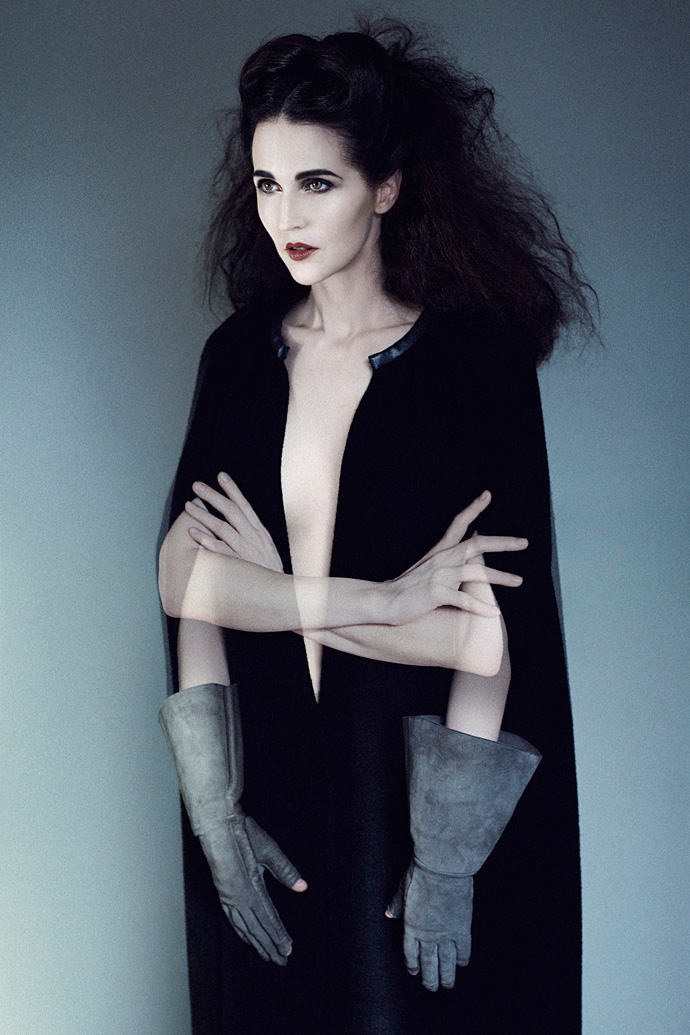 KALI, Suzanne von Aichinger wears a Rick Owens cape and gloves, all FW2011. Photography by René Habermacher
KALI, Suzanne von Aichinger wears a Rick Owens cape and gloves, all FW2011. Photography by René HabermacherI always liked her and when we finally became friends, I liked her even more. In the following conversation Suzanne shares her thoughts on fashion, music, talent, the water, mythology and other obscurities. You are about to discover the muse, the model, the artist, the stylist..
I caught her leg on her daybreak between styling for a Vogue photo shoot and organizing a major project.
FILEP MOTWARY: Hi beautiful? So it was very difficult to catch you in the past two months. What have you been up to?
SUZANNE von AICHINGER: I know Filep. I’ve been a little like Houdini…escaping. But for a good reason. I had plenty of work and styling projects
Tell me more about it please. It seems you work non-stop.
It’s been good for me lately. I’ve been styling some perfume campaigns, editorials for Russian Vogue, Italian Vanity Fair, doing photos with Dita, and now I’m preparing another perfume campaign, and a major photo shoot with one of the MOST gorgeous women on the planet.
Oh Gosh, indeed its a lot. You mean the actress, Elisa Sednaoui? Ali posted a shot of her on twitter…
Oh what a beauty Elisa is!!! But, I’m referring to another lady…very iconic. I don’t know if I should say who it is. I don’t like to talk about things before they come out…
I understand. How easy it is for you to collaborate with people. What a concept needs to have in order to get you involved in it?
Collaborating with people is my ultimate way of creating. I find the dynamic of working with another or others, stimulating, and proven a successful way of expression for me.
How do you make your choices? Is money an important motive or not always?
There has to be an element that compels me, something that excites my imagination. I also have to feel that I have something relevant to bring to the story. Money is very often not a motive. But, sometimes it is an essential part of creation. We must also live, make a living, etc. You have to know when to give and when to sell!! There is no shame in being paid for a job well done. Andy Warhol considered making money the highest art form. I’m not sure that I adhere to this philosophy, but I don’t love being broke either. I like the freedom that having some cash on hand can procure you.
On the other hand there might be talented people, who would love your contribution but, lets say, cannot afford you. How would you react in such conditions?
I usually say YES to a project, which stimulates me. It’s not about the $$$. It’s about the action. I believe in working with people that I consider talented or kindred spirits. As people of great talent have wanted to work with me, when I had no money to pay them. Just for the sheer joy of seeing an idea become a reality.
I wanted to ask you about the photo shoot you just did with René Habermacher. It’s so iconic, yet in a very special way. How was working with René?
I loved it. We had a beautiful day together, with a great creative team. We wanted to express in this series, something that is based more on personality, than fashion. I feel that there are many stories to be told in my future with René. There is a quality in his vision that is very strong and appealing.
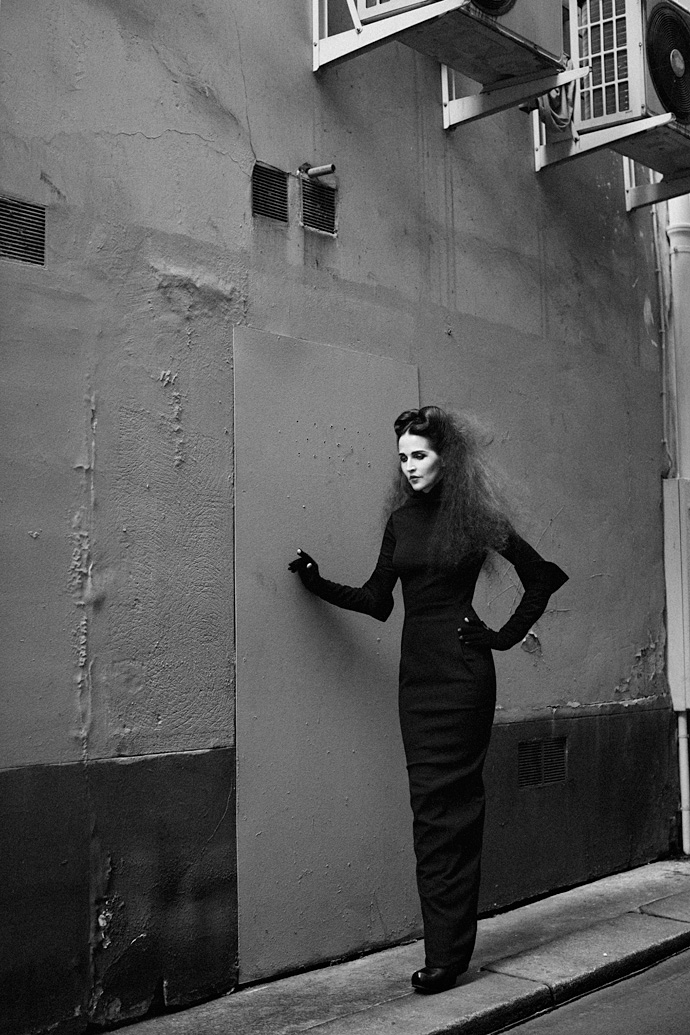 CASSANDRA, Suzanne von Aichinger wears a Rick Owens dress, boots and gloves, all FW2011.
Photography by René Habermacher
CASSANDRA, Suzanne von Aichinger wears a Rick Owens dress, boots and gloves, all FW2011.
Photography by René HabermacherExactly my point. The photographs serve our conversation so right! I’m very happy that Rick Owens was so positive when I contacted him for the garments. He is always so nice to me. Also for the fact that we shot his winter collection which is by far my favorite!
So am I! I LOVE Rick! He is one of my favorites. And, his fashion is timeless. I know that this can sound cliché, but if you have some pieces by Rick from 12 years ago, they are as relevant as pieces that he has made 2 days ago. They don’t go in and out of fashion. They have their own essence and place.
Having in mind that Rick’s clothes are so special, yet the 2000’s are the epitome of diversity. Each designer points out a different outline every season, there is so much choice. How do you see fashion now yourself, as a stylist?
It’s hard for me to answer this. I see many great things happening, no doubt. But, I see a lot of nonsense going on as well. There is not enough power any more in the hands of the creators. Now, big design houses change designers like they change their underwear. Just ridiculous. There is no time for the designer in place to create a brand identity, that he is fired. And very often, they find out that they’ve been fired, by reading about it in the papers.
It’s as if the financial/commercial people at the heads of some houses, envied the position of creator, and wished to usurp it. They believe that they are capable of being the creator. WRONG!!!!
(more…) -

NEXT: SUZANNE von AICHINGER
-In Greek mythology, the Sirens with the irresistible charm of their song, lured mariners to their destruction on the rocks surrounding their island..
In modern mythology, Sirens are dressed in Rick Owens, pose for photographer Rene Habermacher and share their secrets and thoughts on current and past affairs with Stimuleye Filep Motwary…
Stay tuned..
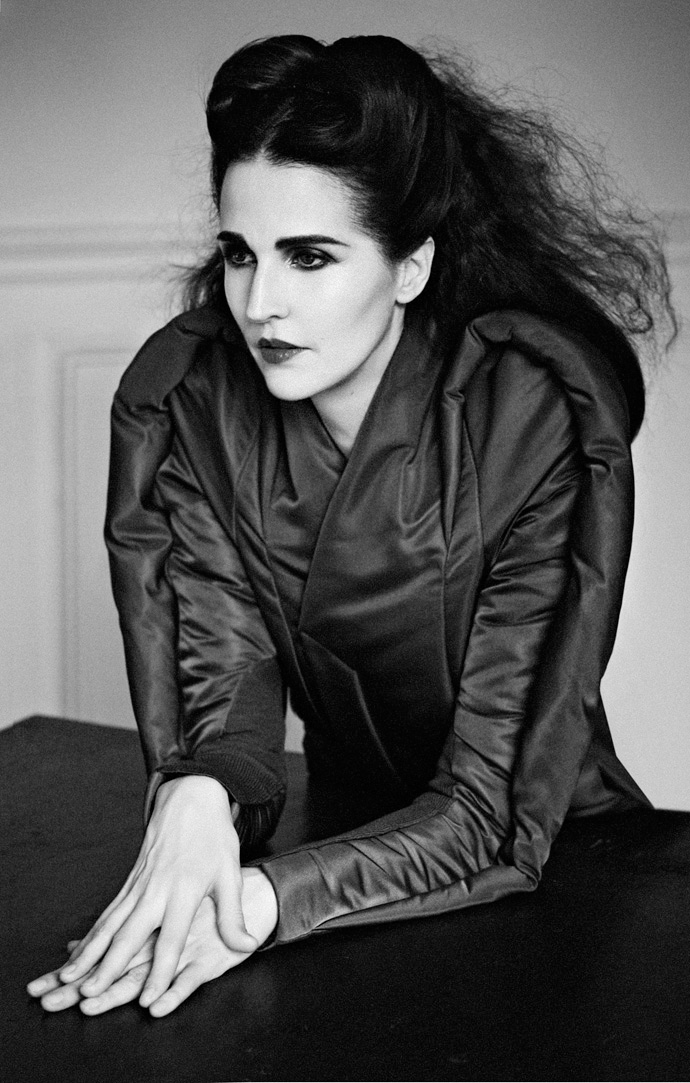 Siren Suzanne von Aichinger wears Rick Owens FW2011. Photography by René Habermacher.
Fashion Editor : Ines Fendri ⎜ Make Up : Akiko Sakamoto ⎜ Hair : Karin Bigler ⎜ Production : Lynsey Peisinger
Siren Suzanne von Aichinger wears Rick Owens FW2011. Photography by René Habermacher.
Fashion Editor : Ines Fendri ⎜ Make Up : Akiko Sakamoto ⎜ Hair : Karin Bigler ⎜ Production : Lynsey PeisingerWhat was the last thing that stimulated you?
Suzanne von Aichinger:
“Shooting Haider Ackermann’s portrait for Vogue.” -

RICHARD GRAY “owns his own teeth”
-Richard Gray of the Sunday Times and 1O & 1O MEN talks to Filep Motwary
Richard Gray is a Taurean – but don’t hold that against him. He studied modern languages at University but hasn’t spoken a word of it since. He loves fashion and carbs and not necessarily in that order.
He was recently followed into the men’s room at Claridges by Morrissey but nothing came of it. Richard owns his own teeth. He is not a virgin. He is however verging on the ridiculous. He writes lots of stuff on fashion for Sunday Times Style, 10 and 10 Men. He’s open to bribery.
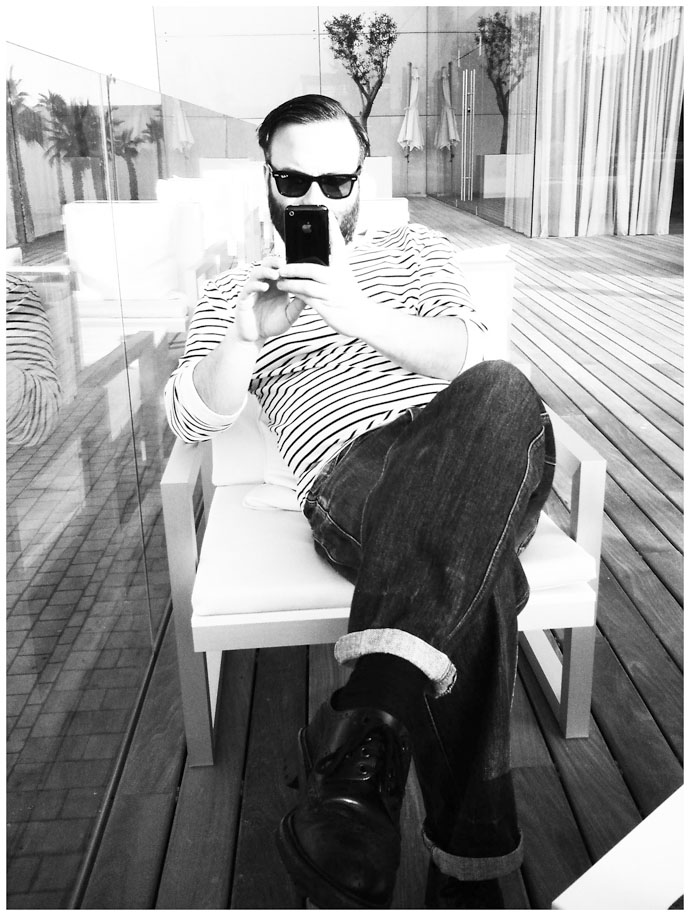 Richard desperately tries to hide a hang over behind his shades in Barcelona at the opening of the W hotel.
Photograph by Alastair Jamieson
Richard desperately tries to hide a hang over behind his shades in Barcelona at the opening of the W hotel.
Photograph by Alastair JamiesonRICHARD GRAY: Here I am
FILEP MOTWARY: Oh hi there, how are you Richard?
I’m great thank you. And you? This damn London drizzle is doing nothing for my hair however. It looks like a damn (Prada) mohair jumper…Hahah, I saw your video review on Prada’s summer 2011 collection a few minutes ago. I was impressed how you pointed out its references. Really it reminded you of menswear?
And there it is: look at my forehead – it’s fuking scrotal! Anyway, yes, Mrs Prada says she gets dressed from the ground up – so shoes first – it’s a starting point for her. The shoes, the multi-layered ‘platforms’ took their cue from menswear, no doubt about that. The clothes, of course, came from elsewhere. BUT this perverted conceit, that cotton is a luxury fabric, is odd (in a good way). It’s political. She’s political. The price of cotton is through the roof! Rice, oil, rubber: the world’s commodity prices are skewed. This was perhaps on Mrs Prada’s mind at the time. She has a lot on her mind.It seems that you are quite fond of Prada, why?
I think she only finds peace in original thought. There aren’t many fashion designers who share the same mind-space: Rei, Junya, Marc, Raf – we all know who they are. I also think there is something ultimately divisive about a house that caters to the bourgeois – a collective marked by conformity – yet bastardises old ideas/ideals. This is sinister. *Shiver goes down author’s spine*I completely agree with you! On the other hand, I wish to ask you about the new and upcoming designers-if there are any since everything is fading away so rapidly. How difficult is for someone new to become an establishment these days?
Interestingly my assistant Lizzie(Hi Lizzie) went to the St Martins BA fashion design show last week. She said you could feel a move away from classics of the past two seasons and far more adventurous designs one the catwalk now. Good. I suspect however, that young design graduates have more of an eye for business than those of, say, five years ago. They recognize there’s validity in getting your clothes produced and people wearing them. And, more importantly, St Martins and London College of Fashion, the Royal College of Art etc. are now focusing more on the business of fashion. It’s still not easy for a graduate, but they are more business minded on graduation than ever before. Galliano (Yikes! I said his name) argues that talent will always be recognized, despite the difficulties?You mean sooner or later? But, should a young creator first get a job in a big house (as a major designer once told me) or it would be better to try the solo route for starters?
Yes. He uses himself as the ultimate argument that you can fail and fail again. And finally, finally, if you keep trying, incredible talent will be recognized. Not sure how this theory goes down with those who have ended up bankrupt and broken by fashion… The route to success depends on the opportunities that come the young designer’s way. You take somebody like Christopher Kane who did things the textbook way – managed cleverly by his sister Tammy. He’s proved you can do it. He’s a great message for London fashion. Then there’s somebody like Peter Copping, who, I think is on the brink of the global recognition he deserves. He served at Louis Vuitton with Marc but kept under the radar, yet produced some wonderful designs. Now he’s doing wonderful things at Nina Ricci. Both routes can work. Both routes have their own advantages and disadvantages. One thing: being a success in the fashion design world is damn hard. “You pay in sweat!” (See start of ’80s TV horror, Fame for more inspirational advice)I wanted to ask you, if I may, about your opinion on John Galliano, since his name came up…?
The man is clearly not well. He needs, and I hope he’s getting, help. His comments were HORRIFIC and INEXCUSABLE.
(more…) -

ARI MARCOPOULOS talks to FILEP MOTWARY
-Ari Marcopoulos does lie, or does he really? His photographs carry a signature that one may call honest and this what intrigues the most.
Andy Warhol by Ari Marcopoulos©
Through the years of his career, as a serpent does, Ari changed his skin several times, revealing a new and shinier one. What he creates is not about glitter but on the other hand, it may be. Keeping in mind the collaborations his shared and the encounters he found along the way, including Andy Warhol, Basquiat… indeed there are several shiny stones marking his footsteps. Since the early 80’s, Marcopoulos has been photographing the reality of the American culture and all its siblings. Mainstream or not, his pictures and films are out there marking the period we are in. And although his work has often been a subject of surveys by several universities around the world, Ari doesn’t feel a nomad.
This is what he told me while preparing his three new major projects: the camera bag he designed for INCASE along with a limited edition book of unpublished photograph (Now is Forever), a show at the Confort Moderne and finally a movie featuring the Y.S.L collection for SS 2011….
Ari Marcopoulos selfportrait © for DAPPER DAN ISSUE O2
FilepMotwary : Ari, where does this interview find you, work wise and personally? What are you up to?
Physically it finds me with a very bad cold in my bed at home in California. Work wise is always varied, I am in-between assignments. But I am working on new books and sorting out an installation at the Kunsthalle in Vienna. Preparing for exhibitions in early 2011 in Paris and San Francisco. Personally is a hard thing to talk about. Life seems to constantly provide challenges
-

MATTHIAS VRIENS McGRATH EXPLAINS TO FILEP MOTWARY EVERYTHING ABOUT BL33N, HIS NEW PROJECT ALONG WITH HIS HUSBAND DONOVAN
-Its been almost a decade since Dutch magazine closed down and almost six years since my last official conversation with Matthias Vriens. In between and later, many emails regarding our personal news, ideas and hopes took place.
Matthias recently married to Donovan and since then, they both sign as Vriens-McGrath. For a while now I was informed about a new project they have been preparing, BL33N, but finally the mystery is solved, since our last night’s conversation..
BL33N (pronounced BLEEN) is a project by Donovan and Matthias which will oficially launch in May 2011. Since yesterday a rather tantalizingly sexy trailer hit the web in order to prepare us for what’s coming. Bl33n will be an online magazine experience, where all material shot by Donovan and Matthias as a team will support the t-shirts that they sell.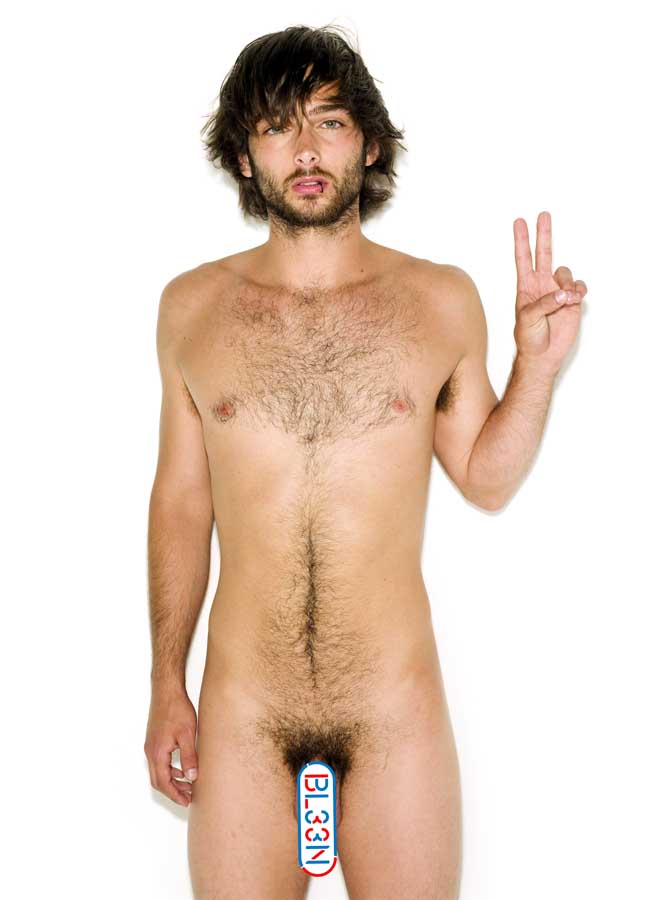 By Matthias Vriens-McGrath.
By Matthias Vriens-McGrath.The first collection is inspired by the body. Its design placed inside the shirt, when turned upside down will become a mask when worn over the face while others will include hair prints on shoulders and back that look like heavy metal or jewelry printed in mirror silver and latex. Printing technics will include latex, glitter. Their aim is to open up to a world wide collaboration of people connecting globally and will include a lot of world travel with the brand, while promoting freedom for all.
“Filep, free, freedom is something we take for granted and not available to all of us. Such an abstract, intellectual property, yet essential for all. We would like to promote freedom for all and with bl33n we intend to do just that. Part of our profit will go to promote freedom.”
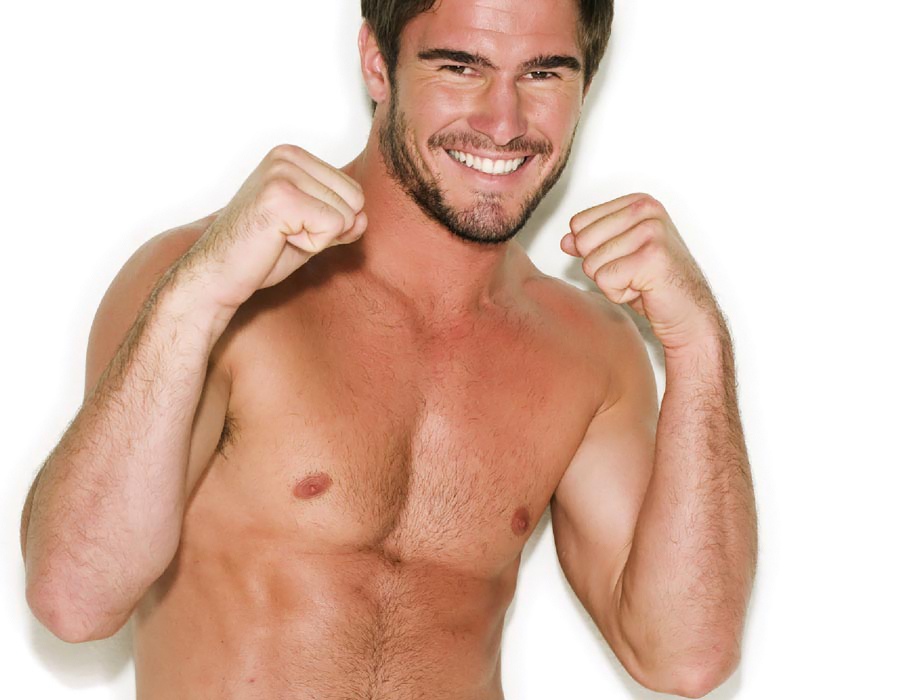
FILEP MOTWARY: So Matthias,how did you come up with the idea of BL33N?MATTHIAS VRIENS-MCGRATH: By accident via google, we found bleen, then bought intellectual property of bl33n.
You were one of the founders of published bible DUTCH MAGAZINE back in the late 90’s and early 00’s. How do you see yourself creating a web-platform?
We are just doing it… and take it from there. As we both have never been one to over-think or over intellectualize matters.
Whats the web’s real power today regarding fashion?
I believe pretty strong, information is scattered around in seconds, no where to hide. As horrid as it can be, once embraced it’s pretty cool and exciting.
Your new project along with your huspand surrounds a variety of actions including orthologic actions like promoting ideas like “freedom for all”. What do you really mean with this?
Our believes are visual delights and as simple as that might seem, the human body in all of it’s glory remains a struggle. Nudity as a metaphor for freedom and its something we all have, yet not available to all of us. Seems simple no…?
I would like to know more about the t-shirt collection you are preparing?
The first collection relates -again- to the body. Monster faces, printed upside down, inside out, become masks when pulled over your head. hair prints draped over back and shoulders printed in latex become ornamental, sculptural jewelry. There will be several collages-shirts that connect to the contemporary art world, while others are printed with the BL33N logo placed on parts of the body that become ‘questionable’
Are you thinking or extent it to a complete collection in the coming future?
Yes, both Donovan and feel strongly about underwear for example, but all in time…
